Red Star FC is a club steeped in history. It is one of France’s oldest football clubs and plays its home games at the iconic Stade Bauer. Plus, the Paris-based team was actually one of the founding members of Ligue 1 — spending 19 seasons in the top flight.
1975 was the last time that Red Star played top-flight football. Since then, they have bounced between Ligue 2 and the Championnat National, the league they currently occupy since suffering relegation in 2018/19.
Former Newcastle and Senegal defender Habib Beye was initially appointed as an assistant manager to Vincent Bordot in 2021. However, when Bordot found himself sacked just six games into the season, Beye took over the managerial job in the interim.
During this period, he guided Red Star to the third round of the Coupe de France and to an 11th-place finish in the league, well away from the relegation places. His impressive managerial performances saw Beye handed a contract until 2024 and tasked with gaining promotion back to Ligue 2.
This very nearly became a reality; Red Star finished just two points off the promotion places last season. During last season, Beye recognised when his team was struggling and made some intelligent tactical decisions to ensure his team remained in the promotion hunt.
In this tactical analysis, we will focus on Habib Beye’s tactics at Red Star. We will look at the 4-4-2 system he used during the 2022/23 campaign and what problems this brought. We will also look at why Beye switched to a 3-4-3 system and analyse the impact this has had on Red Star’s style of play.
Last season’s ‘predictable’ 4-4-2
Throughout most of the 2022/23 campaign, Beye used a 4-4-2 system that, in his own words, ‘demanded a lot of athletic and mental commitment’. Early in the season, it was reasonably practical; Red Star put up some impressive results, such as a 4-2 victory at home to USL Dunkerque and a 4-1 victory away at SO Cholet.
There came a point, though, where it became a little bit too easy for opponents to figure out how Red Star would play. The manager admitted that his team had become somewhat ‘predictable’ and easy to play against. Let’s take a look at what Beye meant when he made this comment:
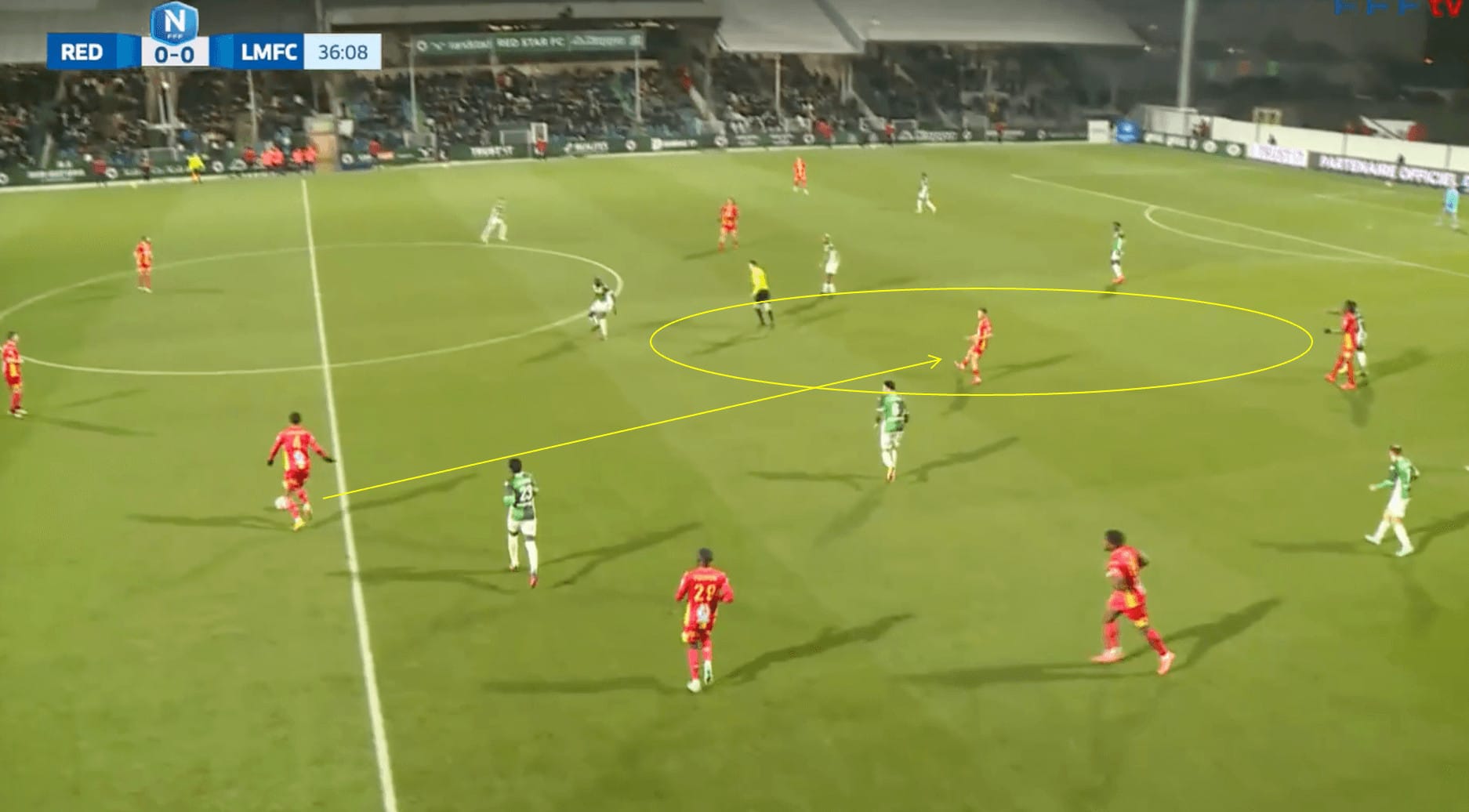
Here, gaps emerged in Red Star’s defensive structure, making it remarkably easy for their opponents to play through them. In this example, Le Mans can fire the ball into their midfielder, who has acres of space to turn and pick out a pass.
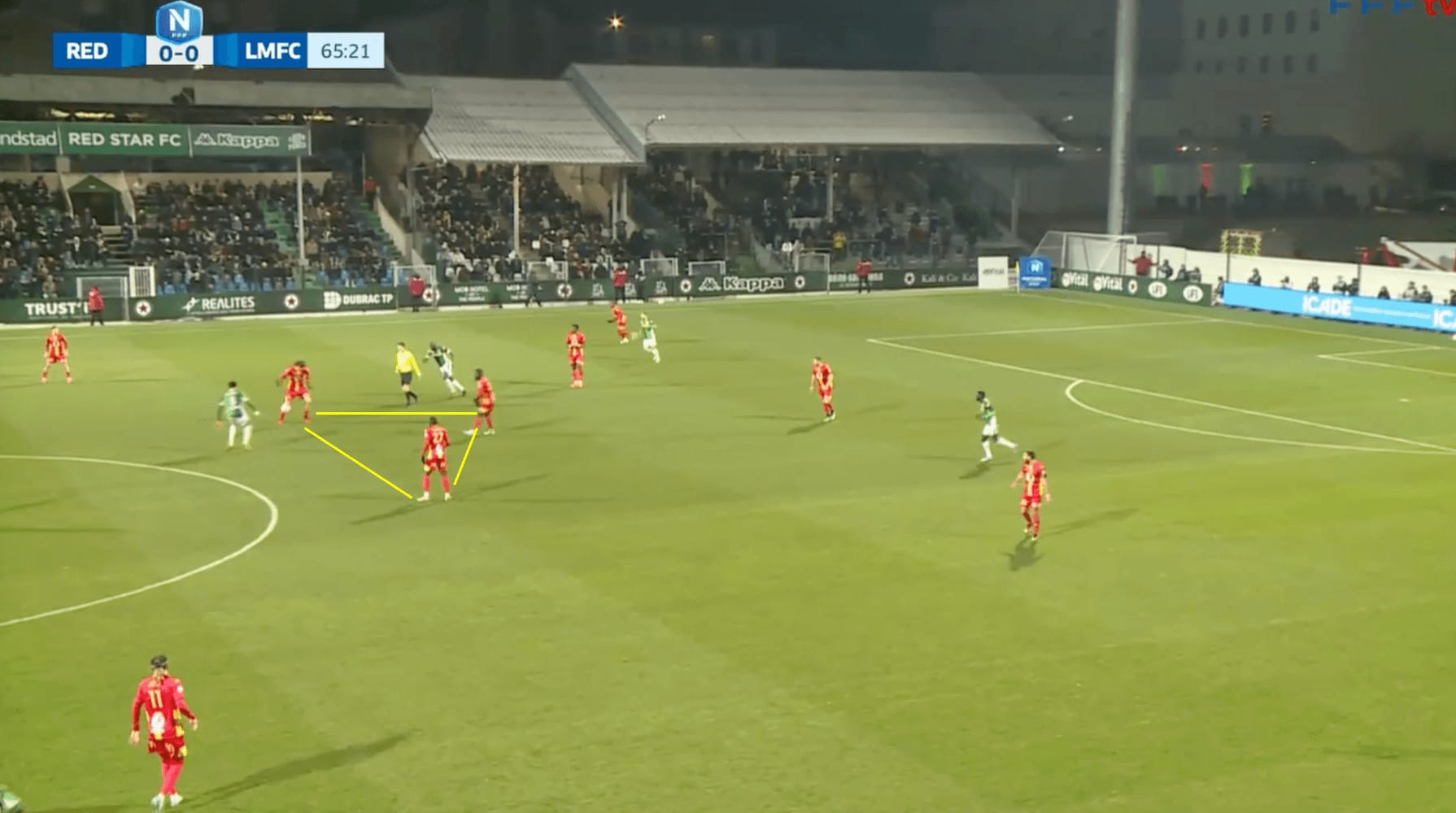
Secondly, the lack of versatility in a 4-4-2 system can lead to stagnation. Two central midfielders may often be outnumbered in the middle of the field against teams employing a three-man midfield.
An example of this is the image above and Le Mans playing a 4-3-3 formation, automatically giving them a numerical advantage in the middle of the pitch. This means that when Red Star lost possession, they struggled to press in the middle of the pitch, and it was straightforward for the opposition to play around them and quickly transition from defence to attack.
Moreover, this numerical disadvantage made it difficult for Red Star to control possession and dictate the tempo of the game. For example, Red Star’s average possession was 47.64% in the 27 games before Beye switched tactics. They saw as little as 34.38% of the ball in some games. This meant that Red Star were often at the mercy of their opponents and had to rely on counterattacks to create goalscoring opportunities.
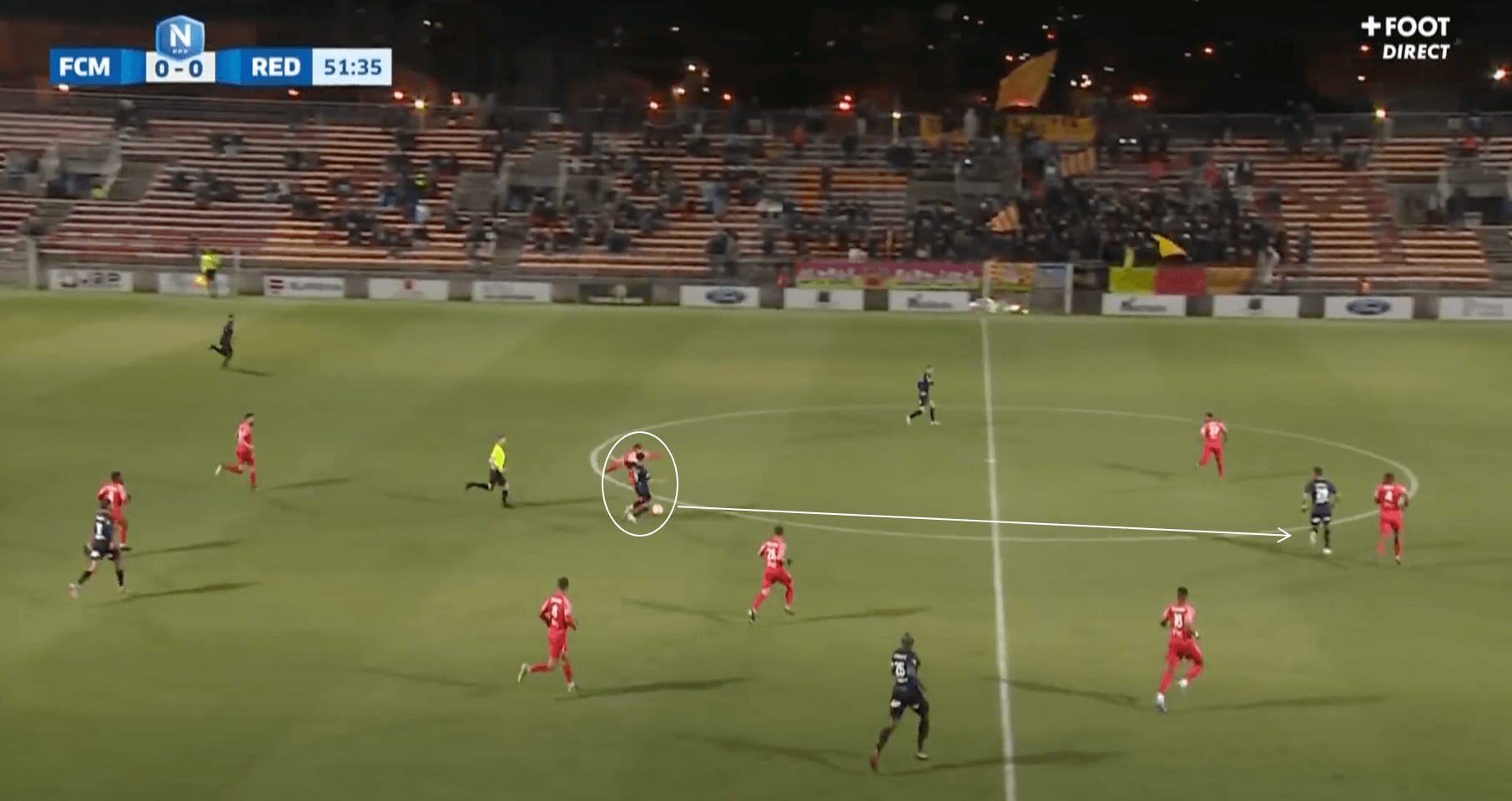
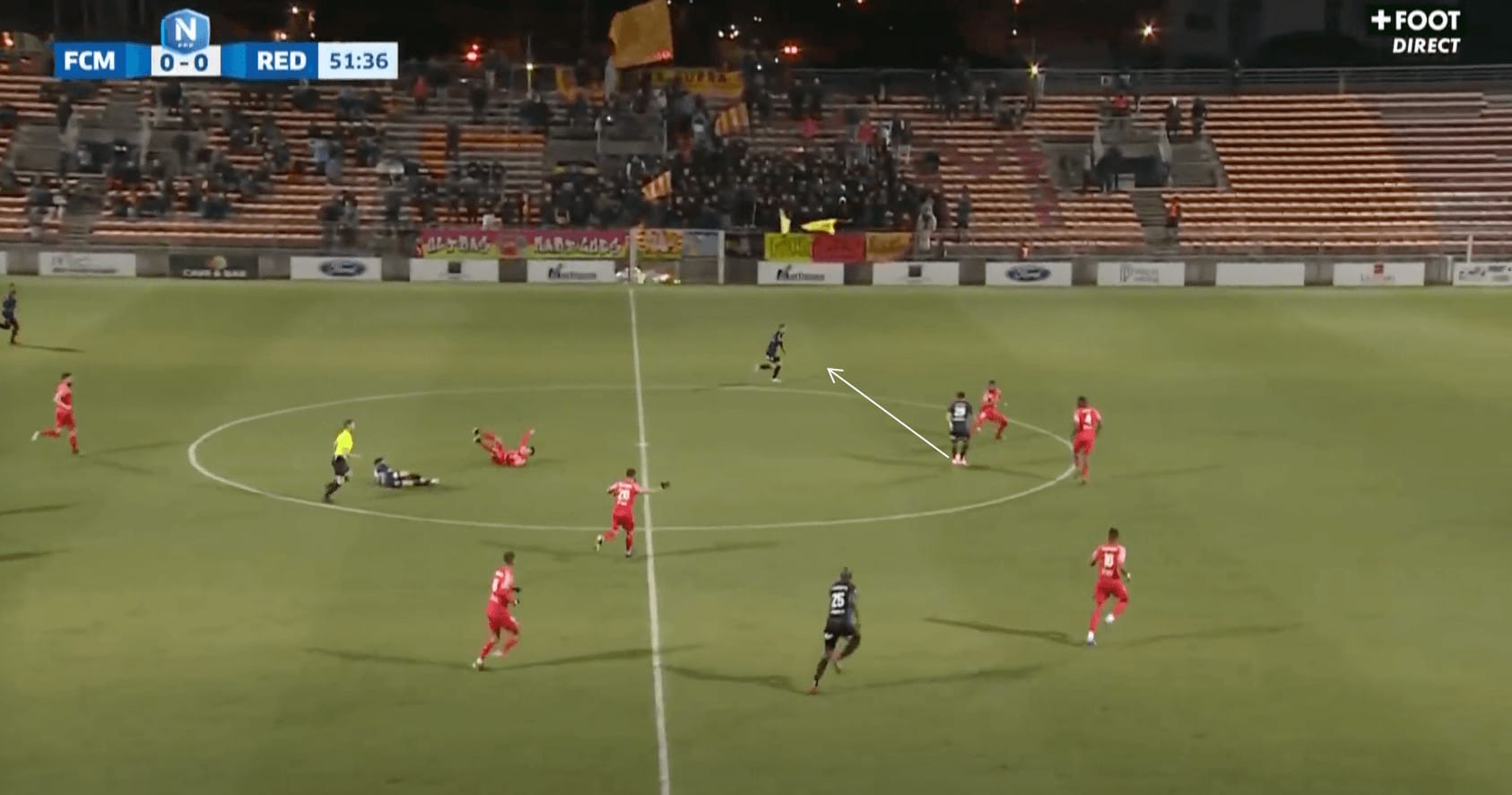
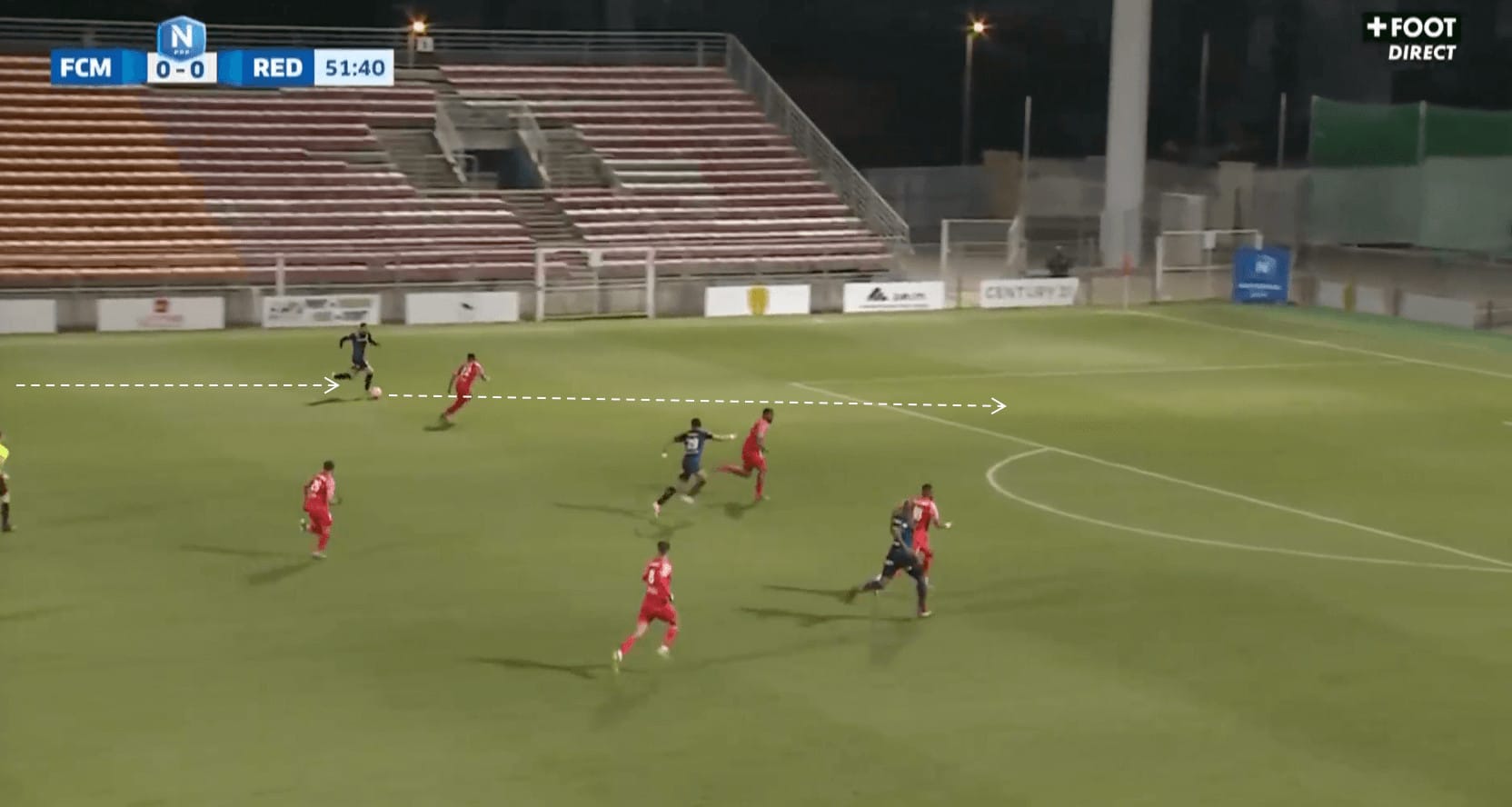
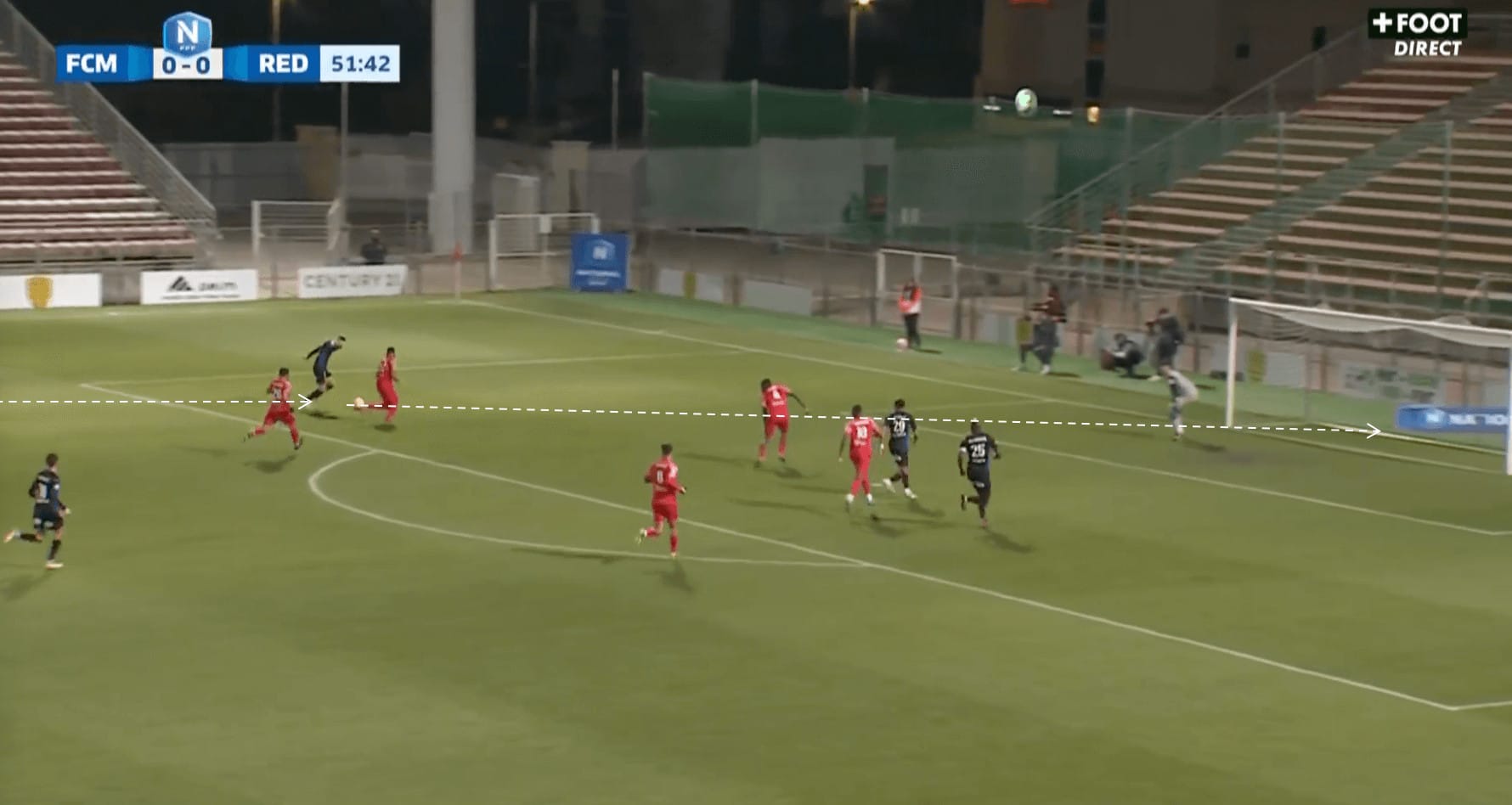
Again, this is not to say that the counterattacking 4-4-2 was entirely ineffectual; we can see an example of Red Star’s counterattacking prowess above. L’Étoile Rouge recovers possession in the midfield and immediately looks to attack. They pass the ball into the feet of Benali, who plays it out wide to Damien Durand. The winger then charges forward and places a powerful shot beyond the keeper.
Following a 1-0 loss in the return fixture against Dunkerque and an embarrassing 4-1 defeat to Concarneau, Habib Beye looked to change things up in a bid to gain more control over games and give his team that spark back as the season drew to a close.
A change of tactic
Beye decided to switch to a 3-4-1-2 system. This immediately provided Red Star with a solid defensive structure as the three centre-backs of Blondon Meyapa, Loïc Kougaba, and Josué Homawoo were able to cover against any counterattacks, which, in turn, gave the attacking players a sense of freedom in the future.
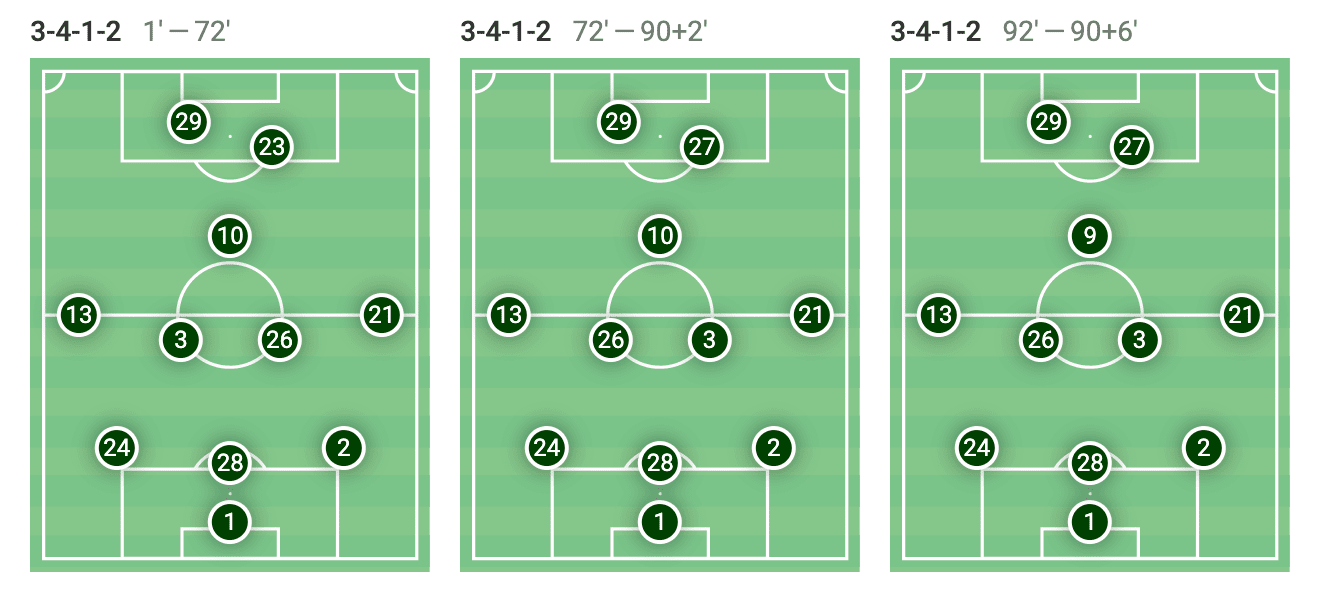
Additionally, Habib Beye decided to play ‘wrong-footed’ wing-backs. In other words, the right-footed Fodé Doucouré lined up on the left whilst the left-footed Aniss El Hriti played on the right. Plus, Ryad Hachem (#3), usually a left-back, played in central midfield – primarily due to his extensive passing range and defensive abilities, which ensured Red Star were not overrun in the midfield areas.
One of the immediate effects of this formation change was that Red Star began to see much more of the ball. In the remaining five games of the 2022/23 campaign, the Parisien team averaged 54.04% possession per 90.
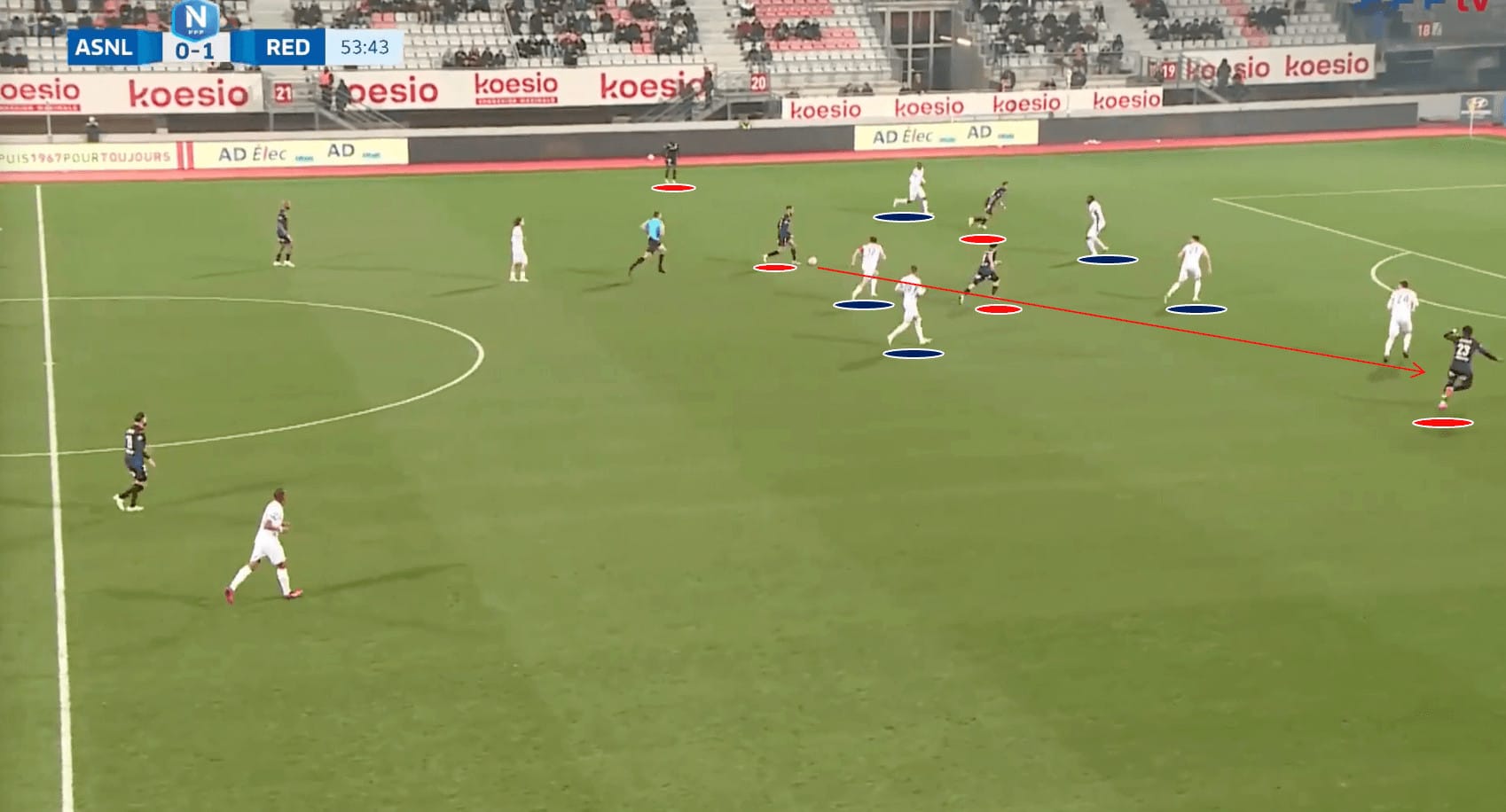
The effect of having more possession became evident rather quickly. As shown above, Red Star promptly shifted away from primarily relying on executing counterattacks to create goalscoring opportunities. They actively built attacks using a specific set of attacking principles.
We can observe that Red Star actively sought to overload one side of the pitch, drawing multiple opposition players across. They sought to utilise the speed of the attacking players and actively switched the play. With a vast number of opposition players in one area of the pitch, it often meant that Red Star attackers engaged in 1v1 situations with their opponents, as we can see below.
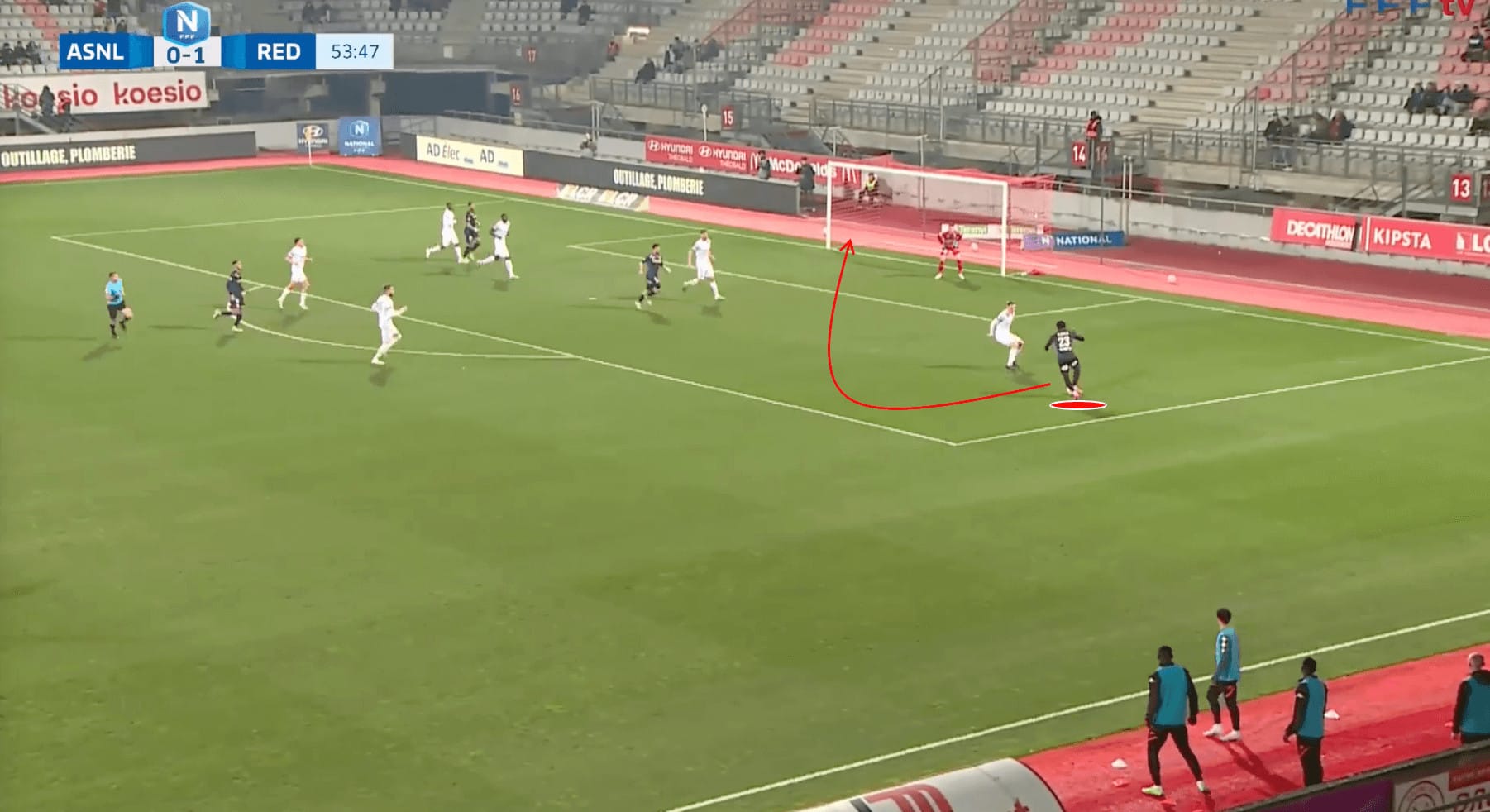
In a continuation of the attacking sequence we saw above, the team shifts the ball out to Jovany Ikanga. He can use his close control and quick feet to beat his opponent, cut back inside and score a left-footed shot into the far corner.
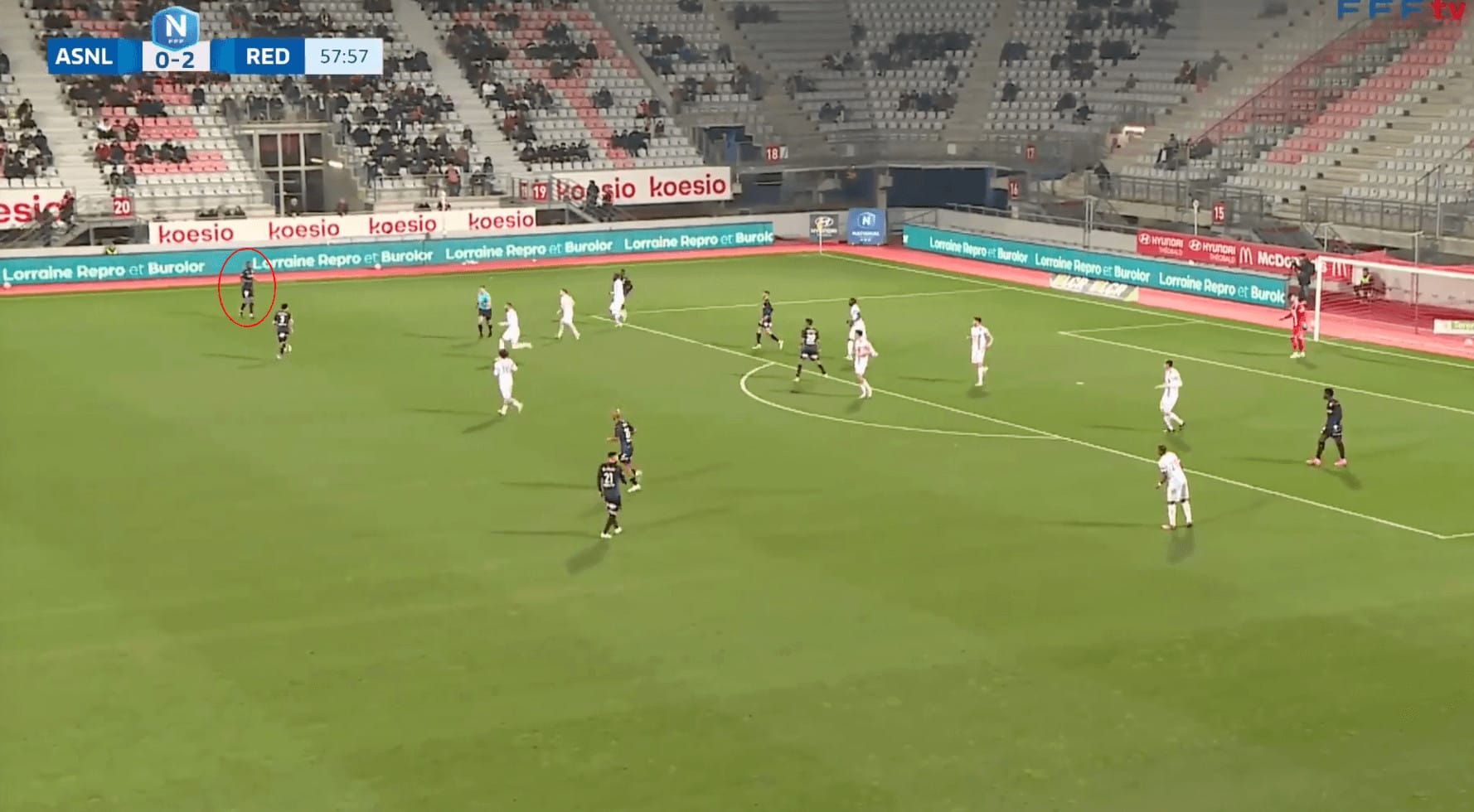
Furthermore, the three-at-the-back system ensured that one of the centre-backs was always available to push forward and ensure that Red Star could maintain their attack. For example, as shown above, Josué Homawoo had pushed further up the pitch.
This action allowed Red Star to pin their opponents back inside their own half; in this example, ten of AS Nancy’s 11 players were back defending. Moreover, AS Nancy couldn’t force turnovers as Red Star could recycle possession, with Homawoo serving as a passing outlet to ensure his team stayed in control.
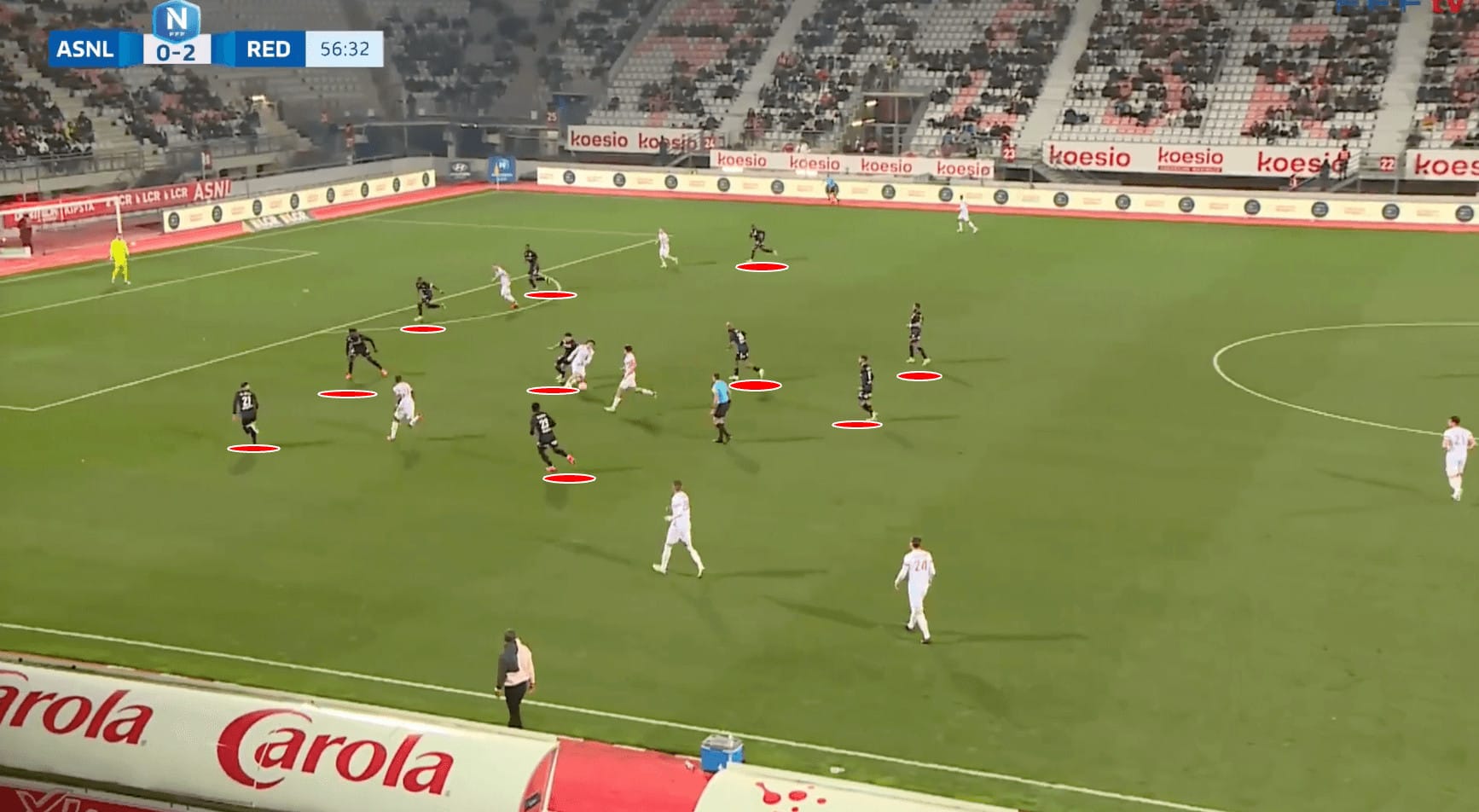
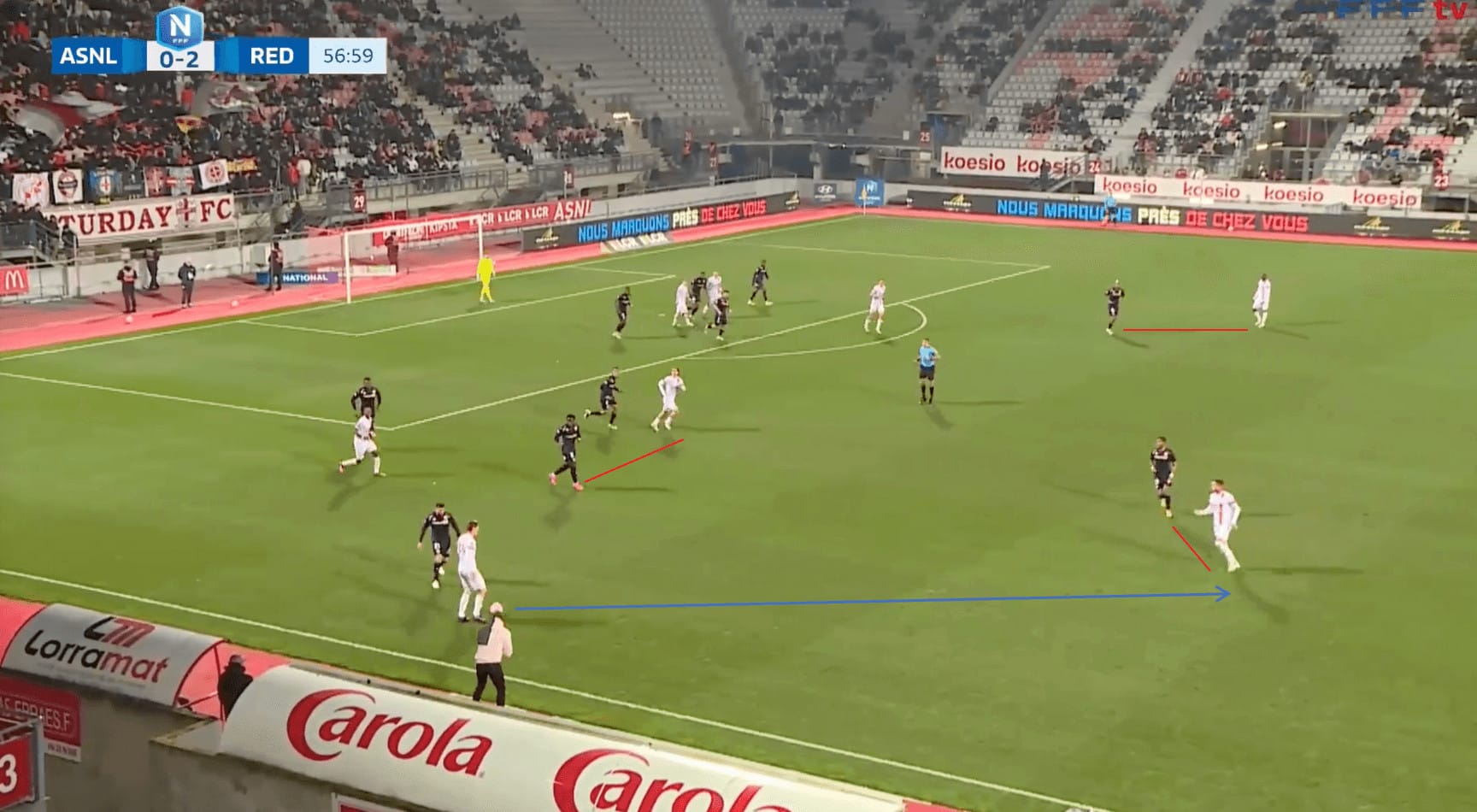
In the first image, we have the teaming from attack to defence; Red Star actively and quickly adopted a compact 5-3-2 shape.
Having five defenders at the back automatically provided the team with a numerical advantage when dealing with the opponent’s attacking players. The numerical superiority meant that opponents found it challenging to discover open space and create goalscoring opportunities due to the compact nature of Red Star’s defensive line.
Furthermore, as depicted in the second image, they actively sought to force their opponents to play in wide areas once Red Star reestablished their defensive shape. Habib Beye’s team then initiated counter-pressing and closed off passing lanes, effectively limiting the opposition’s attacking threat. This proactive defensive approach disrupted the opponent’s ability to construct attacks centrally and actively coerced them into playing in less threatening areas of the pitch.
This, in turn, cut off passing options and ultimately resulted in a turnover, allowing Red Star to regain control of the game and nullify the opposition’s attacking efforts.
Red Star 2023/24: Continuing to counter
Moving into the current season, Habib Beye coaching style has opted to stick with a three-at-the-back system, using either a 3-4-3 or a 3-4-1-2.
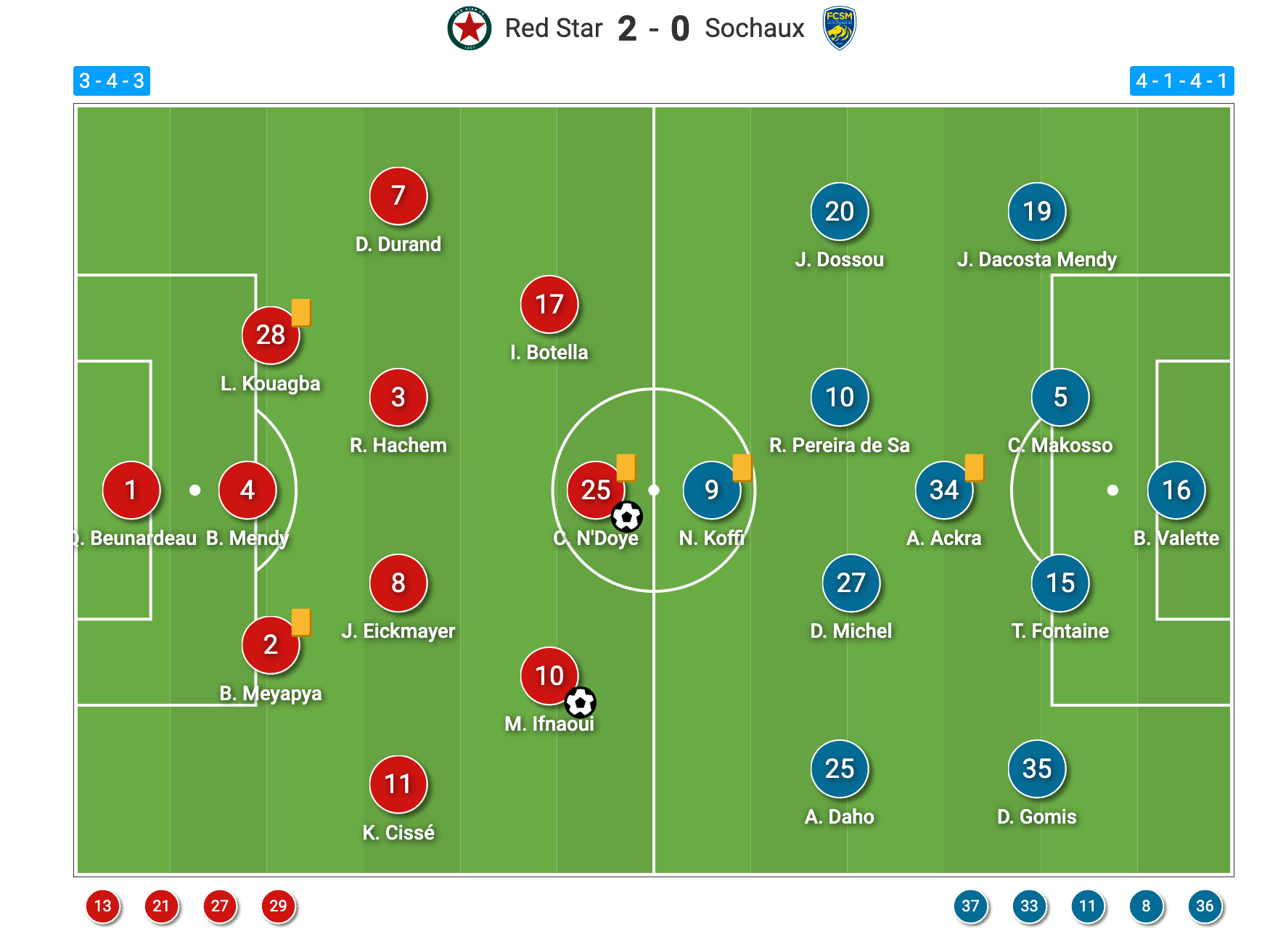
This is the lineup Beye used against Sochaux; we can see he has continued to use Durand, a right-footer, on the left and Cisse, a left-footer, on the right. The summer addition of Joachim Eickmayer brings a steeliness to midfield. At 32 years of age, Bastia Mendy brings a wealth of experience to the back three. Paolo Gozzi has been joined on loan from Serie A side Genoa to provide some cover for the central defenders.
The most exciting signing, though, is that of Ivann Botella from newly promoted Belgian Pro League team RWD Molenbeek. The Spanish forward scored four goals with six assists last season, mostly from the bench, as Molenbeek gained promotion to Belgium’s top flight.
However, Habib Beye’s side enjoys a higher amount of possession during games; this does not mean that they bypass counterattacking opportunities. Below is an excellent example of how Beye’s new system allows Red Star to retain some of their best qualities.
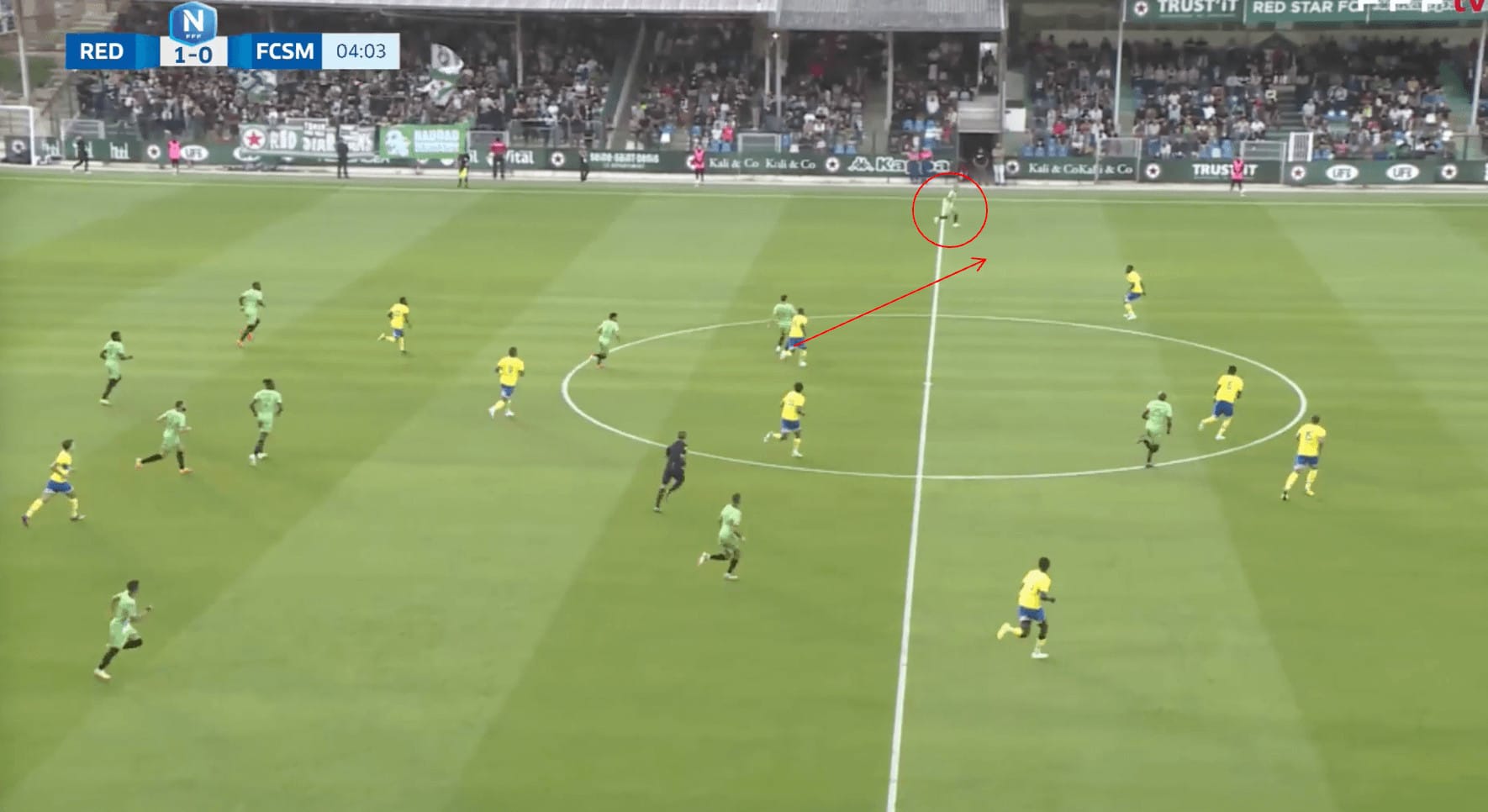
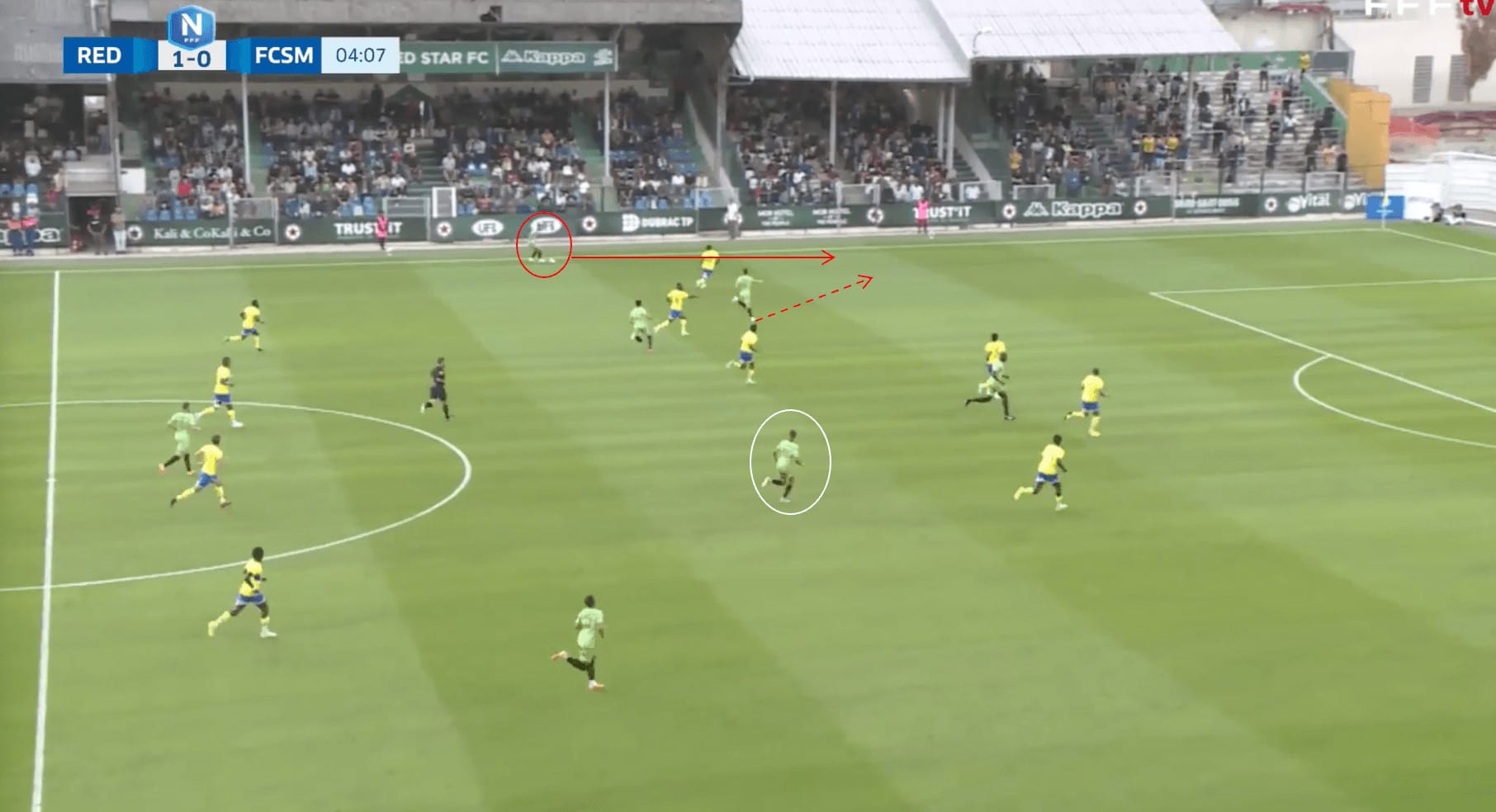
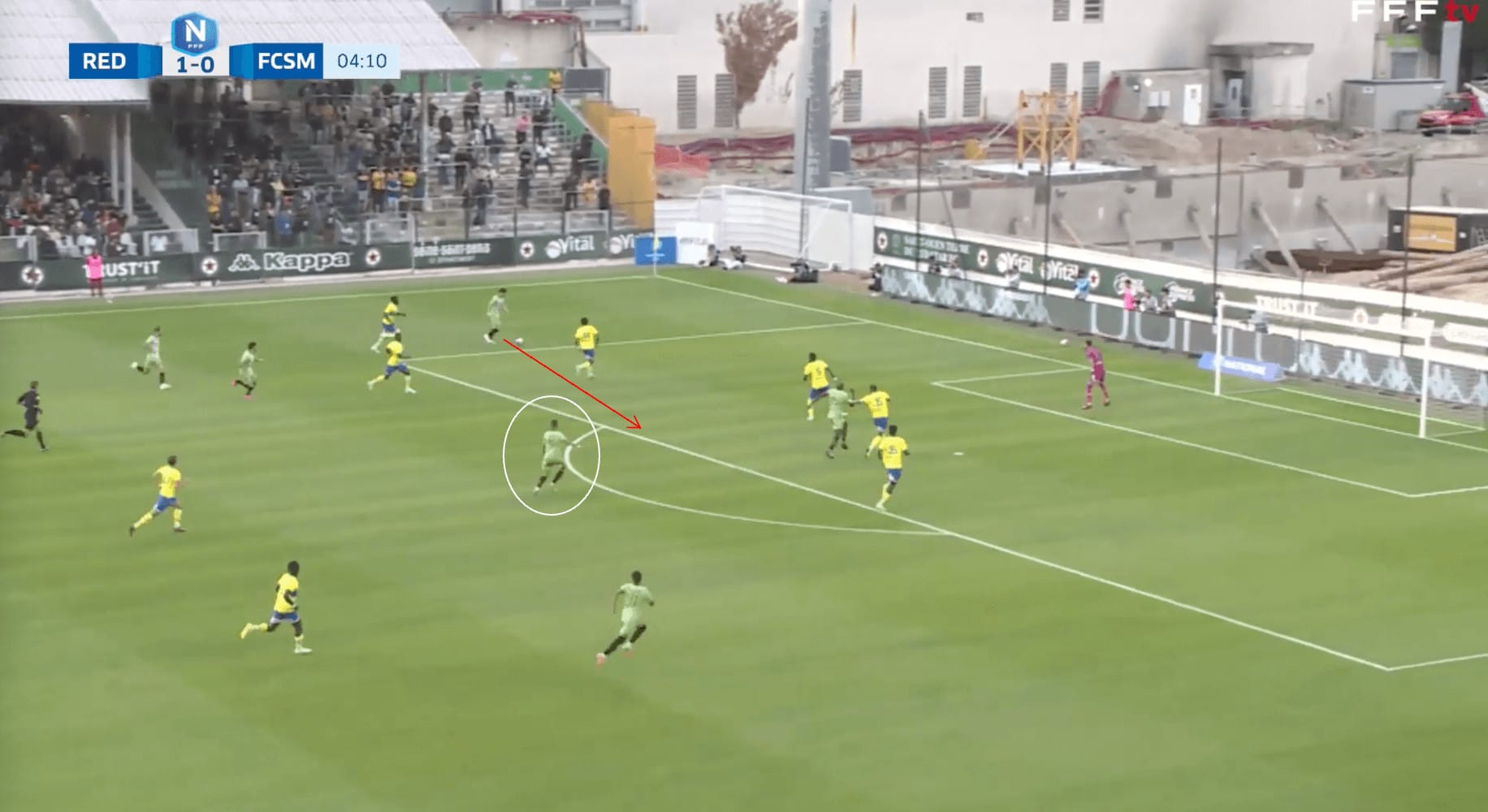
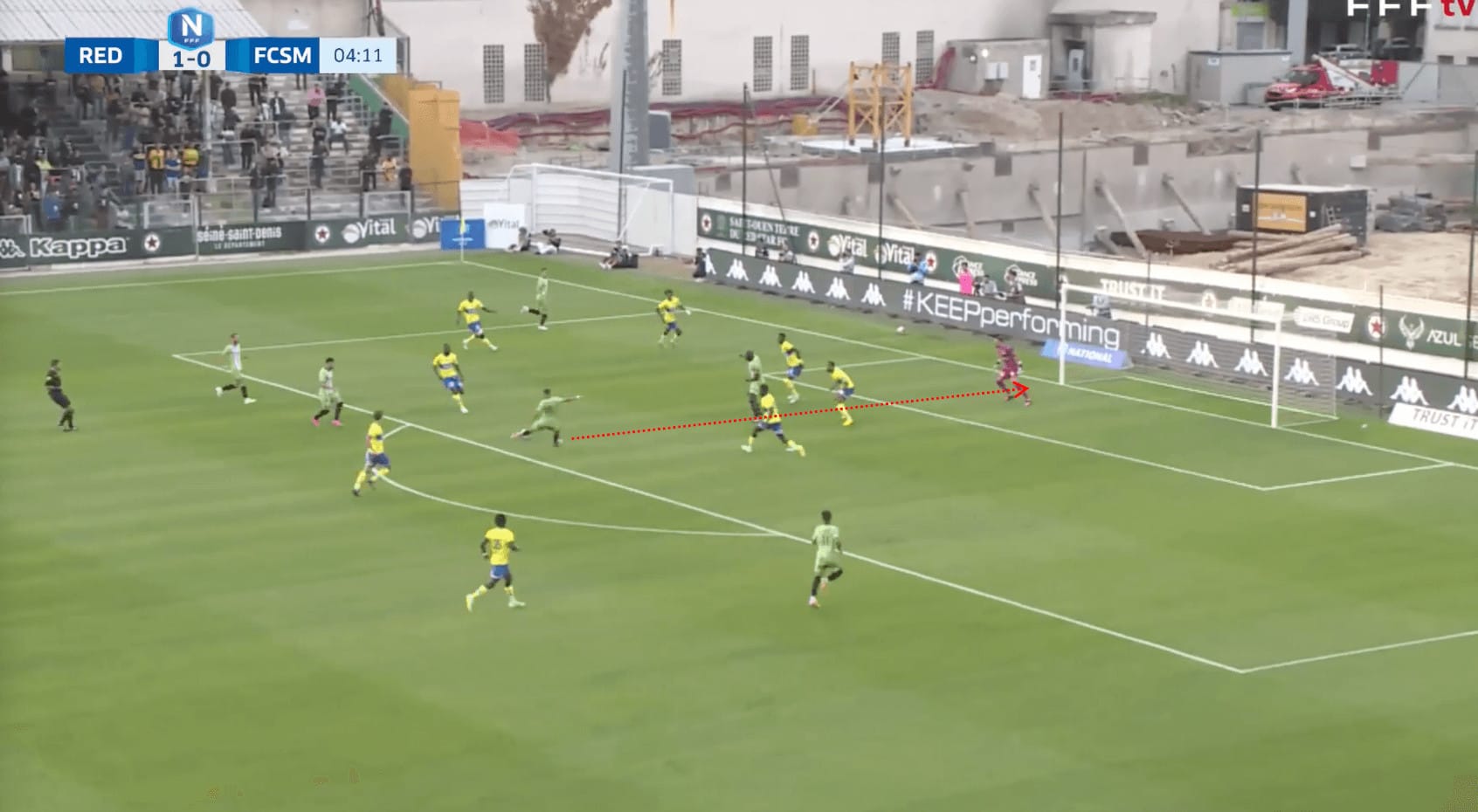
When Red Star regains possession, they consistently execute a particular pattern as they transition from defence to attack, and it often leads to goals. In the first image, after winning the ball on the right side of the pitch, Red Star initiates a sequence where they aim to shift the ball out to the left, creating ample space for Durand to exploit.
As the ball progresses down the left flank, the experienced Cheikh N’Doye makes a run into the penalty area, forcing the opposition to retreat. This strategic move creates room for Merwan Ifnaoui, who positions himself at the edge of the area; the ball then returns to Ifnaoui, who swiftly releases a left-footed shot towards the goal.
In this particular scenario, the goalkeeper saves Ifnaoui’s shot. However, just eight minutes later, Red Star flawlessly executes the exact same sequence, and this time, the 24-year-old successfully finds the back of the net.
Overloads, off-the-ball movement and switches
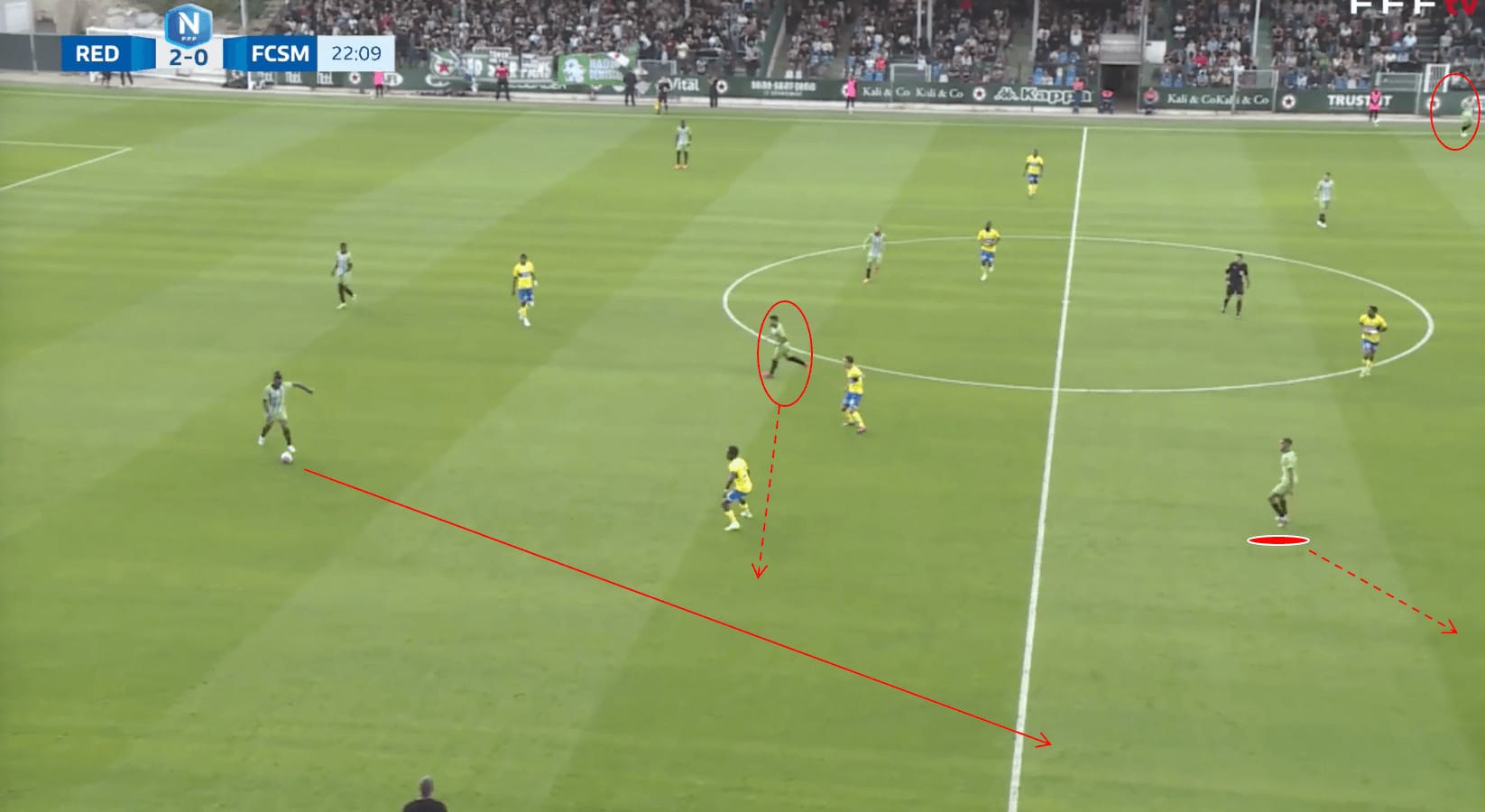
The main principle behind Red Star’s attacking play revolves around getting the ball out wide. To do this, they must first create space down one of the flanks. Habib Beye instructs his team to create space by overloading the opposite side of the pitch through off-the-ball movement, which drags the opponents out of position. In the i. Meanwhile, the team aims to build an attack by playing out of defence. Blondon Meyapya is looking to play the ball to Cissé (who is just out of shot), meanwhile, Merwan Ifnaoui is about to make an off-the-ball run which will drag Sochaux players over to the right flank. Plus, Ryad Hachem (red circle), will make himself available to receive a pass.
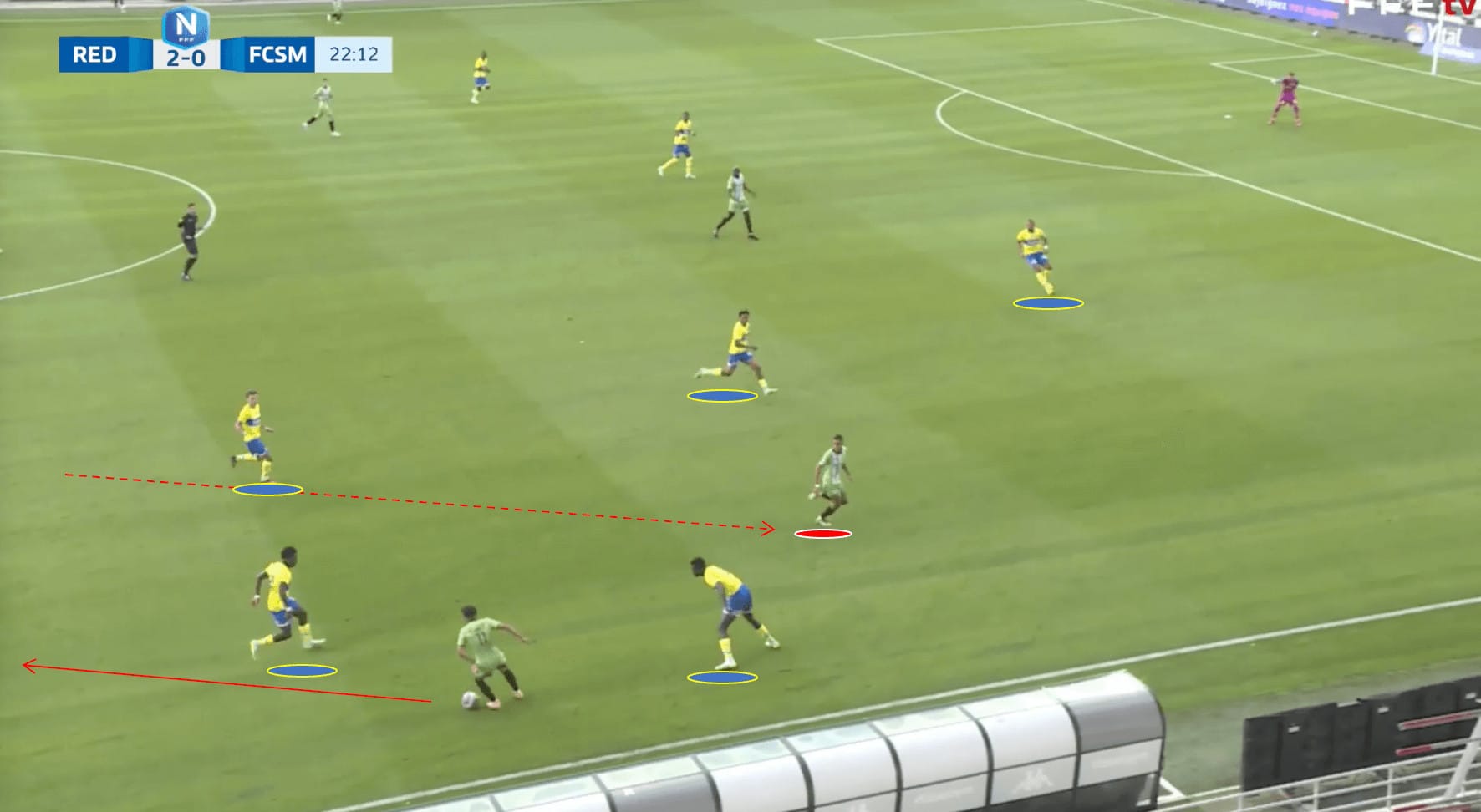
We can see here that Ifnaoui is making a run into the right wing, which has made three Sochaux players follow him. Additionally, Kemo Cissé has received the ball and is looking to play it back to Hachem.
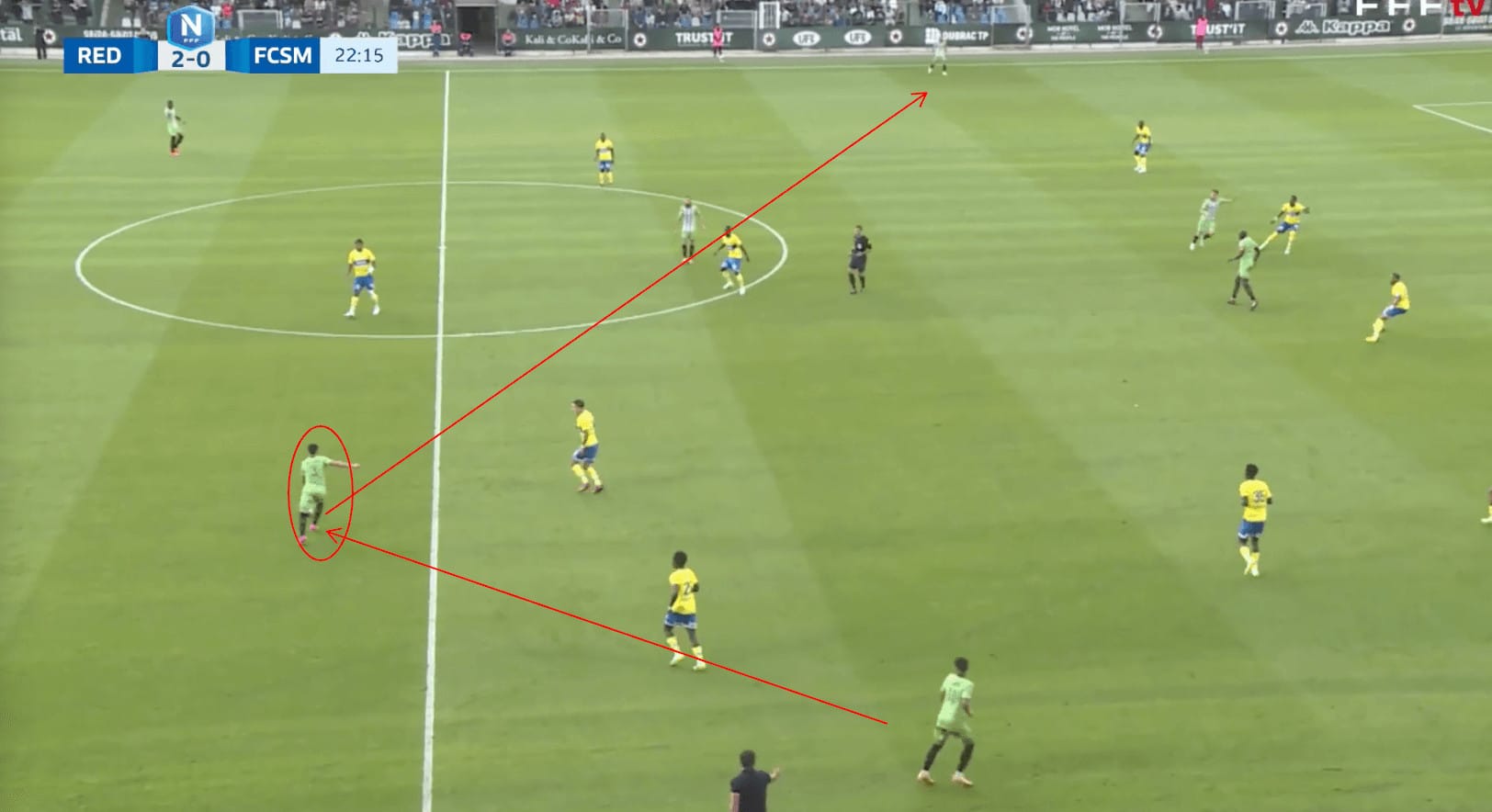
Now Hachem is in possession and quickly looks to switch the play over to the left, where Durand is waiting in space. By Ifnaoui dragging the Sochaux players with him, the remaining defensive players adjust their positioning as it looks like Red Star are going to attack down the right flank. By executing a quick switch, Habib Beye’s side are able to exploit the space on the opposite flank.
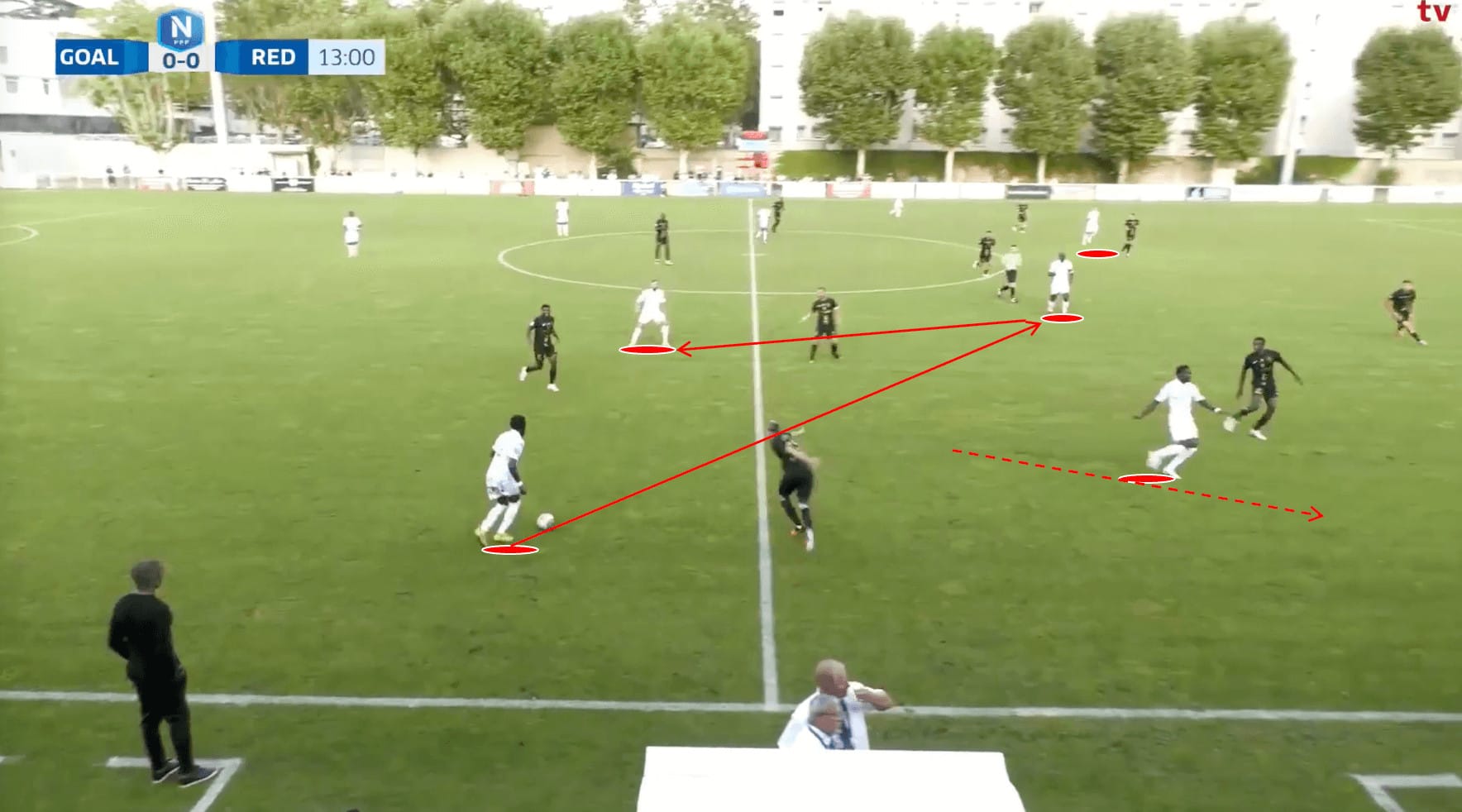
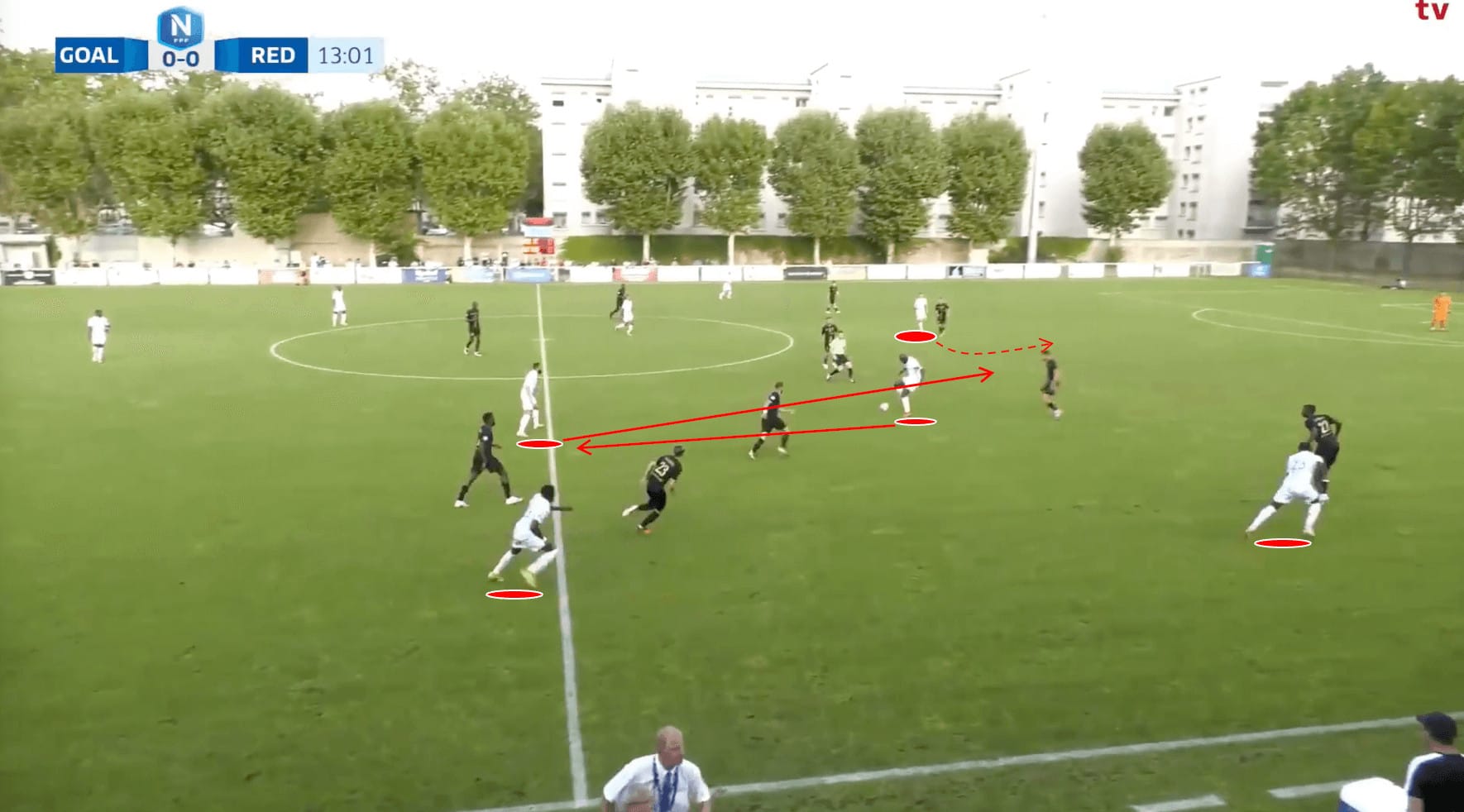
In this instance, we can see another example of Red Star’s off-the-ball movement. This time, Ikanga makes a run into the wide area whilst Doucouré fires a pass into N’Doye, who has dropped deeper. He then lays the ball off to Ifnaoui who plays a first-time pass into the path of Botella. These swift rotations and passes are critical to Red Star unlocking their opponent’s defence.
Third man runs
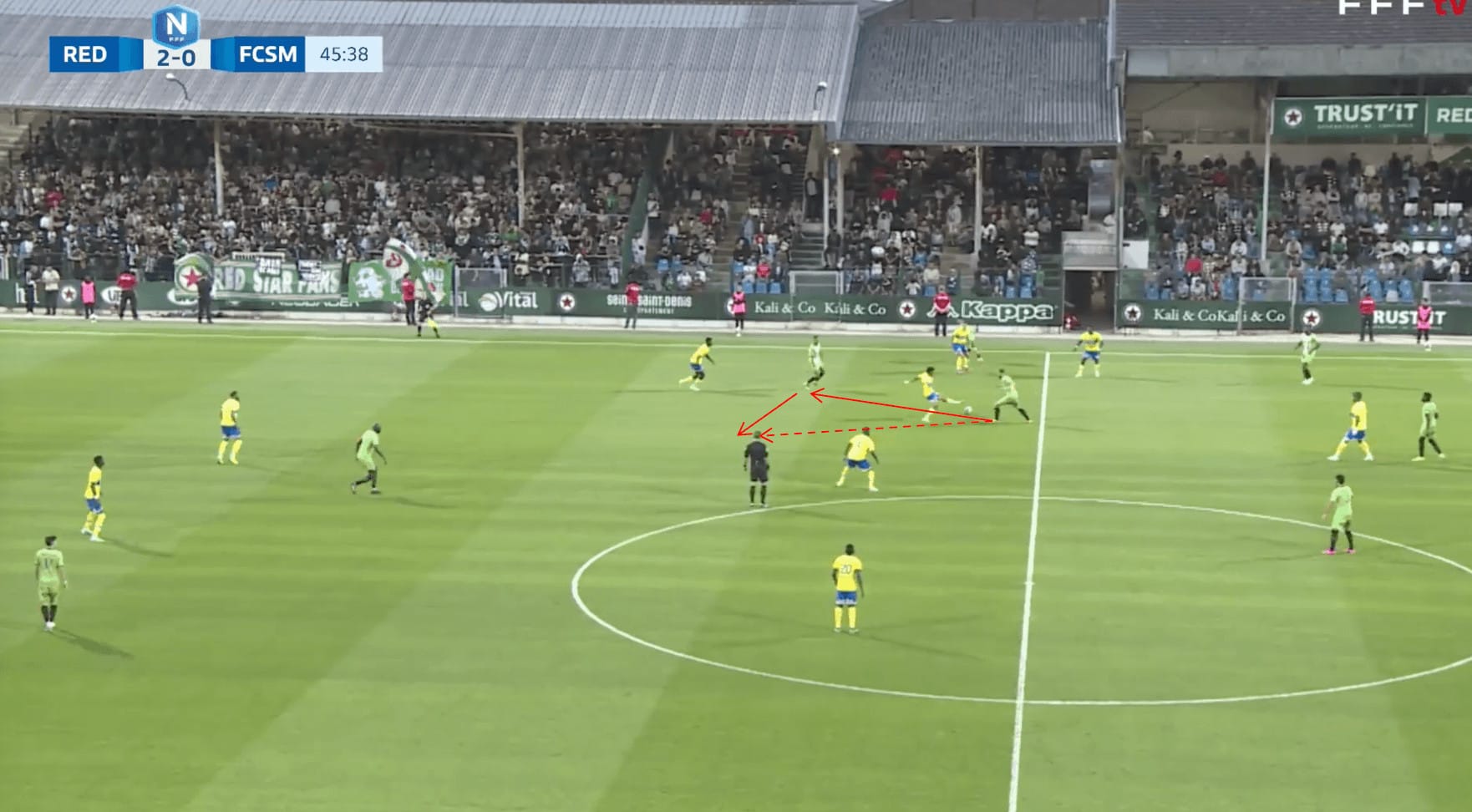
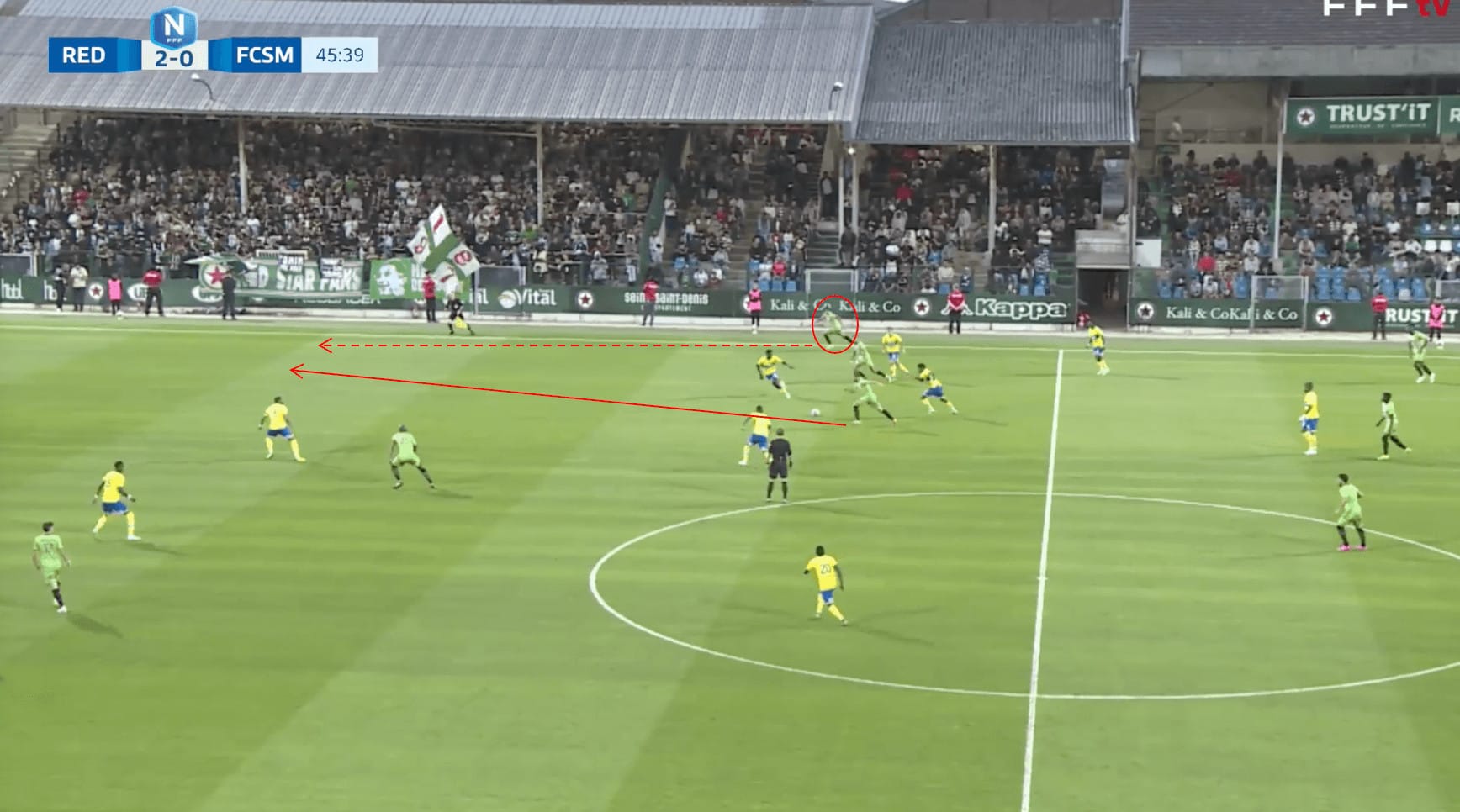
Additionally, in the attacking phase, Red Star will look to utilise third-man runs in their build-up play, particularly in the wide areas. One primary advantage of incorporating third-man runs is that it shows their ability to create space and overload areas of the field, which, as we know, is a critical element of Red Star’s attack.
In the images above, we can see that Eickmayer and Ifnaoui play a give-and-go whilst Cissé makes a run down the right flank.
The quick interchange of passes between Eickmayer and Ifnaoui draws the Sochaux players out of their defensive structure. Causing the defenders to step out of position allows Cissé to make a line-breaking run down the wing.
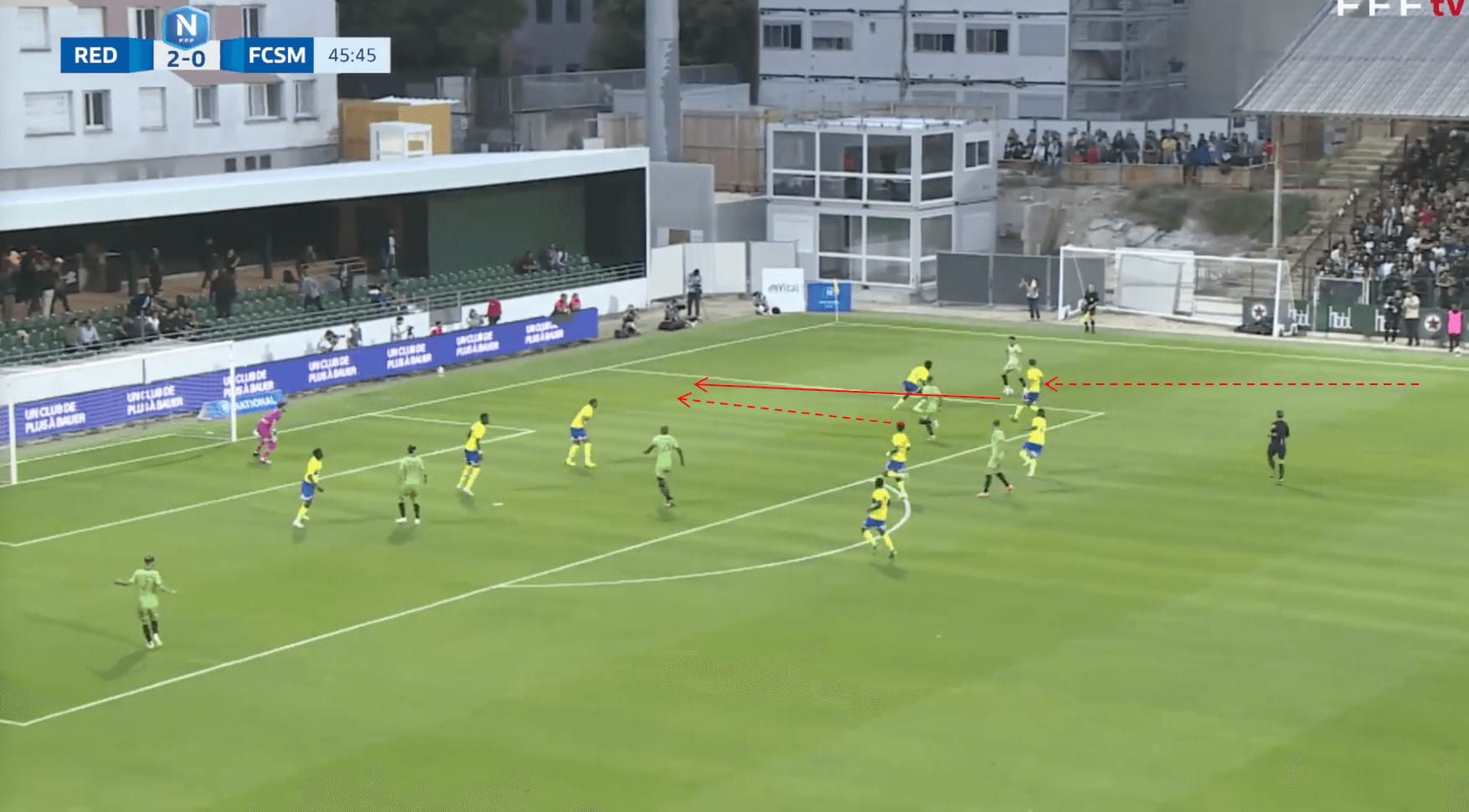
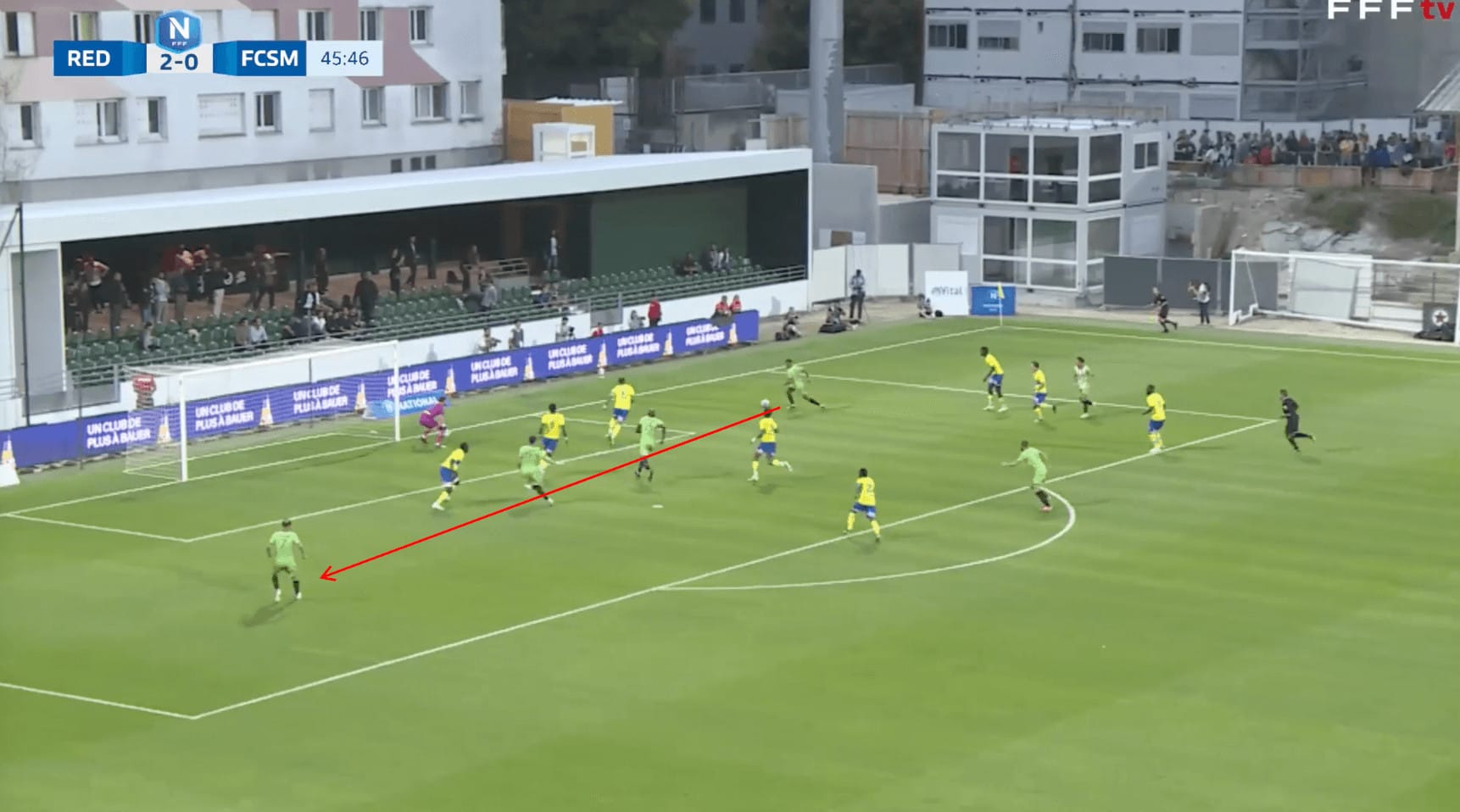
We can see here that Cissé carries the ball down the wing; as a left-footed player, Sochaux expect him to cut back inside onto his favoured foot. Instead, he plays a pass to Ifnaoui, who has made a run into the space left unguarded. Ifnaoui crosses the ball into the path of Durand, who can take a shot on goal.
Successful execution of these third-man runs requires the Red Star players to be aware of each other’s movements and intentions. There needs to be synergy and cohesion among the attacking players to make the team more dynamic and difficult to defend against.
This movement allows Habib Beye’s team to create space, exploit gaps, and break defensive lines, making them more capable of breaking down well-organised defences and creating goalscoring opportunities.
Defensive vulnerabilities
Although Beye has successfully transformed Red Star in an attacking sense, that does not mean that they are unbeatable. As with any formation or tactical system, there are vulnerabilities that opponents can’t look to exploit, which we will explore in this section of the analysis.
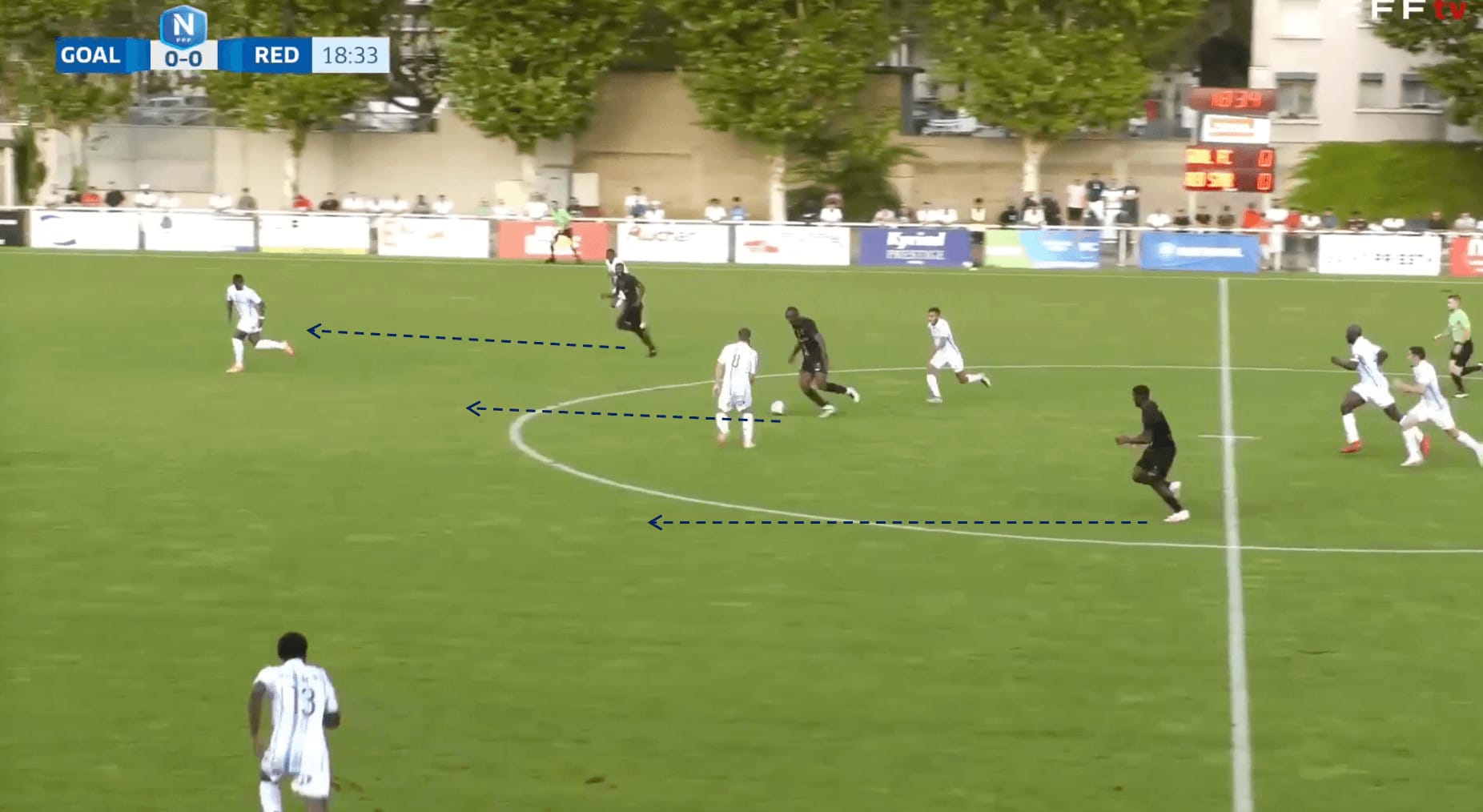
Firstly, transitioning from attack to defence can be a challenge in the 3-4-3 formation as we can see. When the team loses possession, there is a lack of immediate support for the central defenders. This lack of defensive structure can make it much easier, allowing it to exploit spaces between the lines or launch quick counterattacks.
Here, for example, we can see that the midfielders have lost possession and this allows GOAL FC to spring a counterattack. With three runners looking to get into the box, the GOAL attackers are man-for-man against the Red Star centre-backs. The 3-4-3 offers much more defensive stability but it is still possible to catch Red Star out in the middle of the pitch.
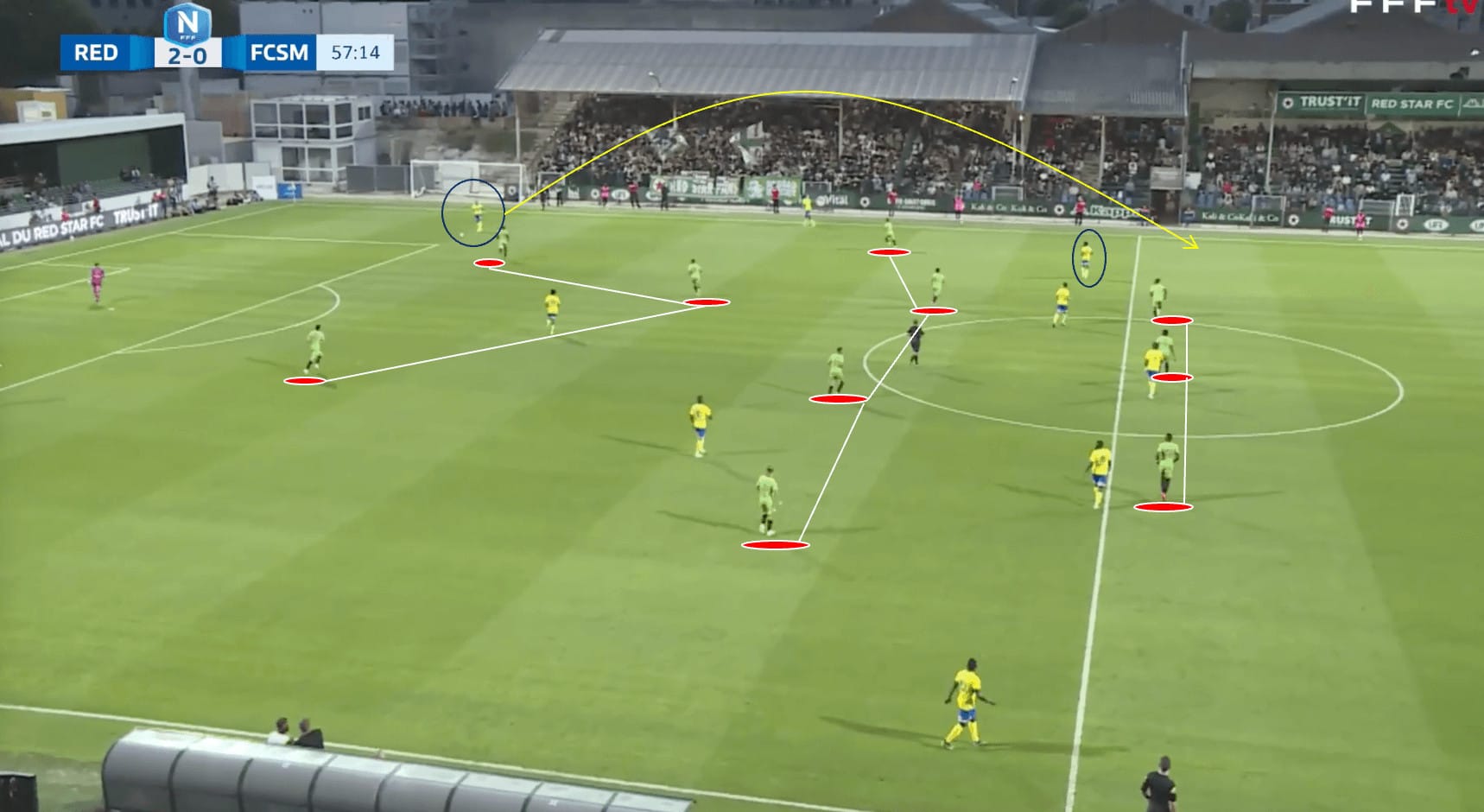
There is another way in which opponents can bypass Red Star’s tactical system: going long. The image above shows Habib Beye’s team in their defensive structure of 3-4-1-2, which becomes a 3-4-3 in the press.
Due to the wing-backs pushing up to form the four-man midfield, it leaves a considerable amount of space in behind. We can see here that due to Red Star looking to pin the opposition, they push up high; therefore, a well-executed pass into the space behind the wing-backs could cause chaos.
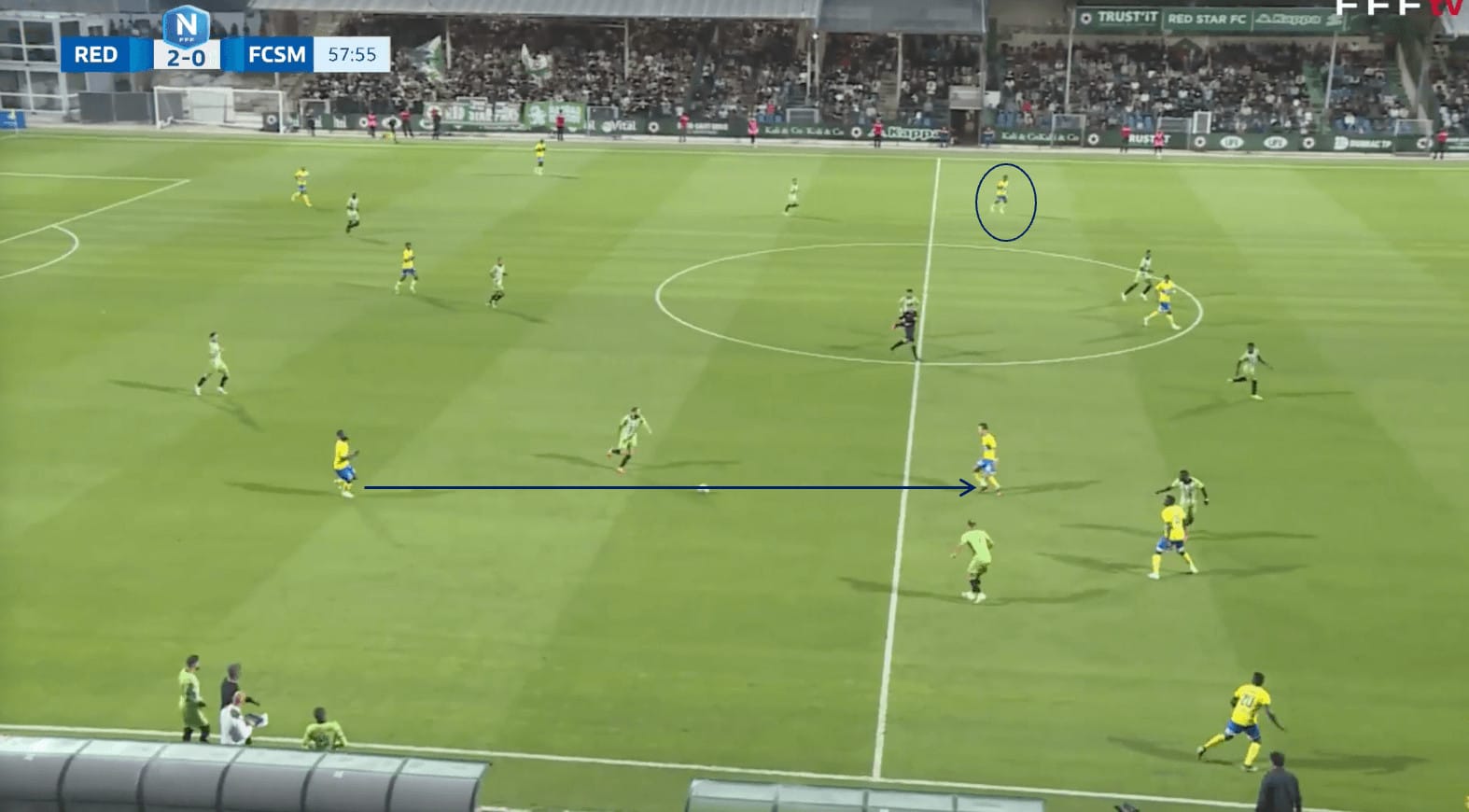
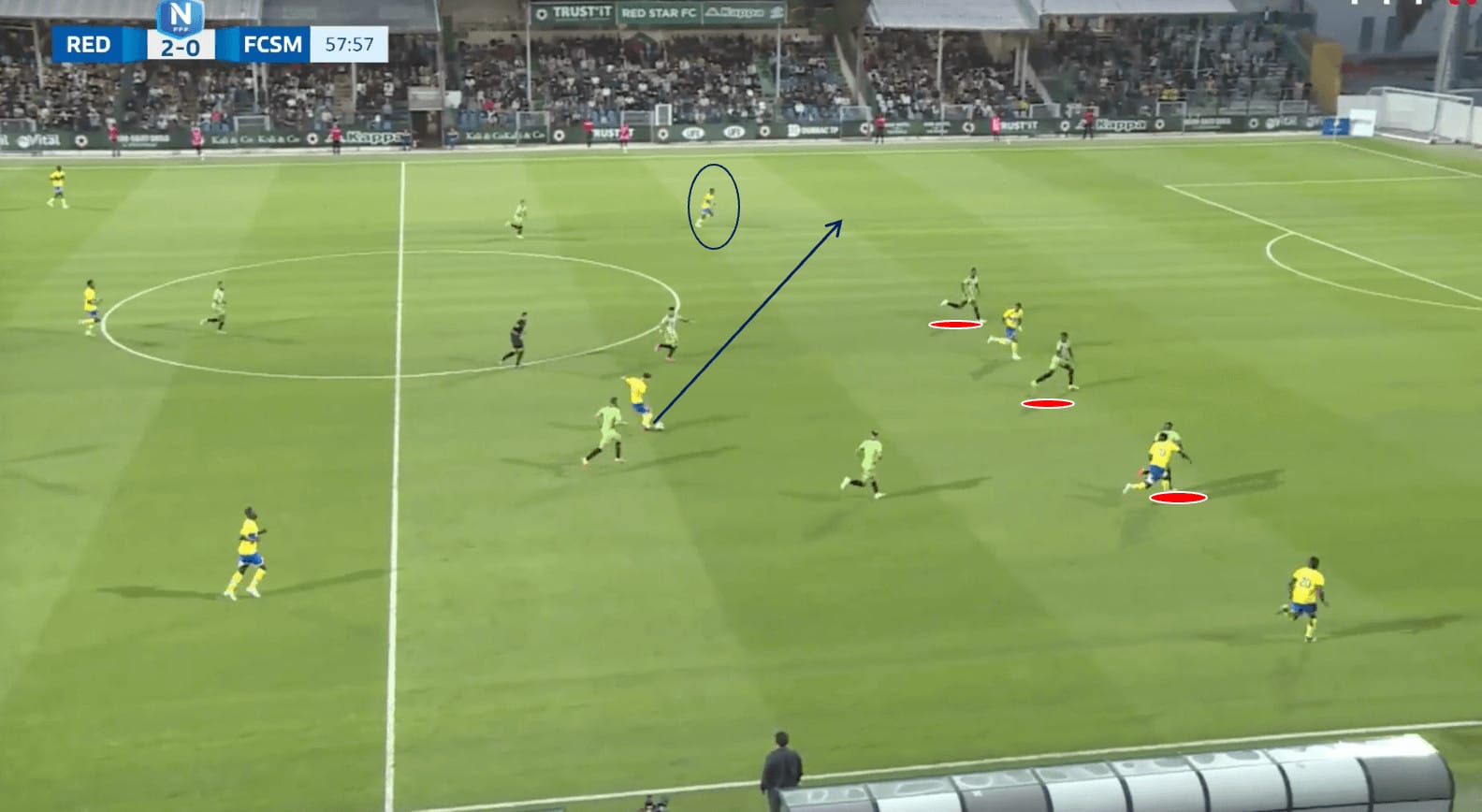
Additionally, we know that Red Star likes to cut off passing lanes to prevent their opponent from building an attack. However, as we can see here when the opposition manages to play out of the press, it can leave L’Étoile Rouge short of numbers in defence.
As we can see, the ball is then played into the space that has been left due to the right wing-back getting forward and Sochaux have an opportunity to carry the ball into the penalty area.
So, although the 3-4-3 provides Red Star with a much more solid defensive structure, there are definitely some defensive vulnerabilities they need to be aware of.
Conclusion
In this tactical analysis, we have looked at why Red Star’s 4-4-2 system became easy to play against last season. We have also analysed why Habib Beye chose to use a 3-4-1-2 and a 3-4-3 system.
Red Star have started the season well, but as we know, the Championnat National is a tough league; undoubtedly, there will be many twists and turns along the way. The squad appears to be well-balanced, and Beye has put a tactical system in place that allows the team to control the game and create more goalscoring chances.
Whether Red Star will gain promotion is impossible to predict, but they will most likely be in with a great chance. Habib Beye has proven himself to be an intelligent manager, capable of making important calls, such as when to change tactics.
He has already been subject to rumours linking him with a move away from Stade Bauer, though nothing came of the rumours, should he continue to impress, he could become a highly sought-after manager in French football.





Comments